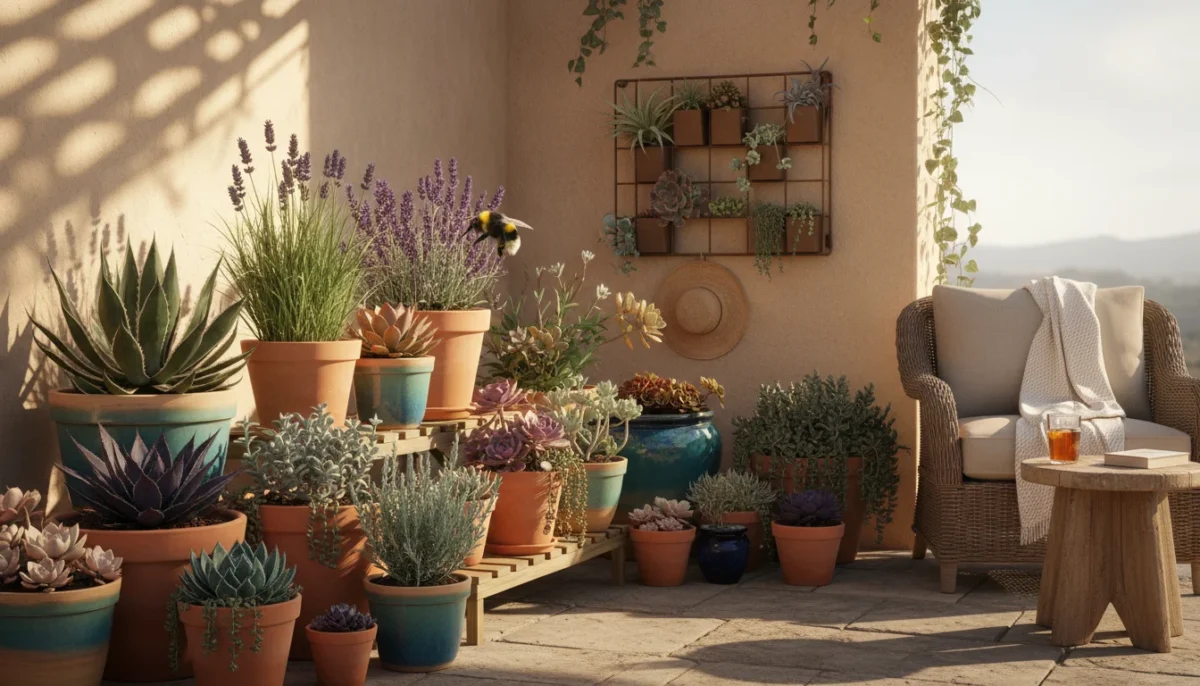Drought conditions are becoming a more frequent reality for many gardeners. You want to cultivate a vibrant, productive garden, even in a small space, without wasting precious water. This guide empowers you with the practical knowledge and actionable strategies to create a beautiful, resilient garden that thrives with minimal water, whether you garden on a balcony, patio, or in a compact yard.
Embracing low water gardening principles means making smart choices about plants, soil, and irrigation. You can significantly reduce your garden’s water footprint, support local ecosystems, and still enjoy the immense satisfaction of growing your own food and flowers. Let’s transform your small space into a haven of sustainable beauty.
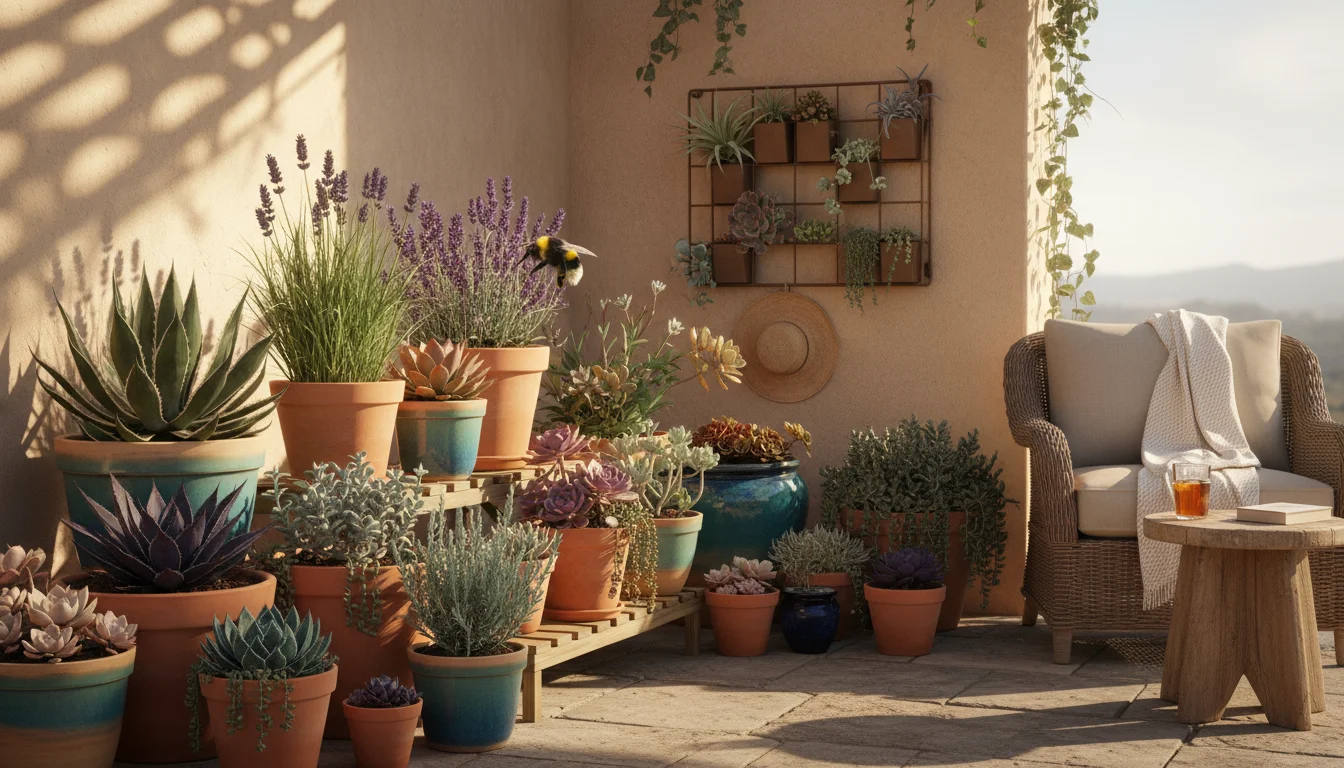
Understanding Low-Water Gardening
Low-water gardening, often referred to as xeriscape gardening, focuses on designing landscapes that require minimal supplemental irrigation. This approach involves selecting plants adapted to arid conditions, improving soil health, and employing efficient watering methods. The core principle is to work with your environment, rather than against it, making your garden resilient in drought-prone areas.
You might think low-water gardening means sacrificing beauty or variety, but this is far from true. Many stunning plants thrive with little water, offering diverse textures, colors, and forms. Moreover, a water-efficient garden often attracts more pollinators and supports local wildlife, creating a richer ecosystem right outside your door.
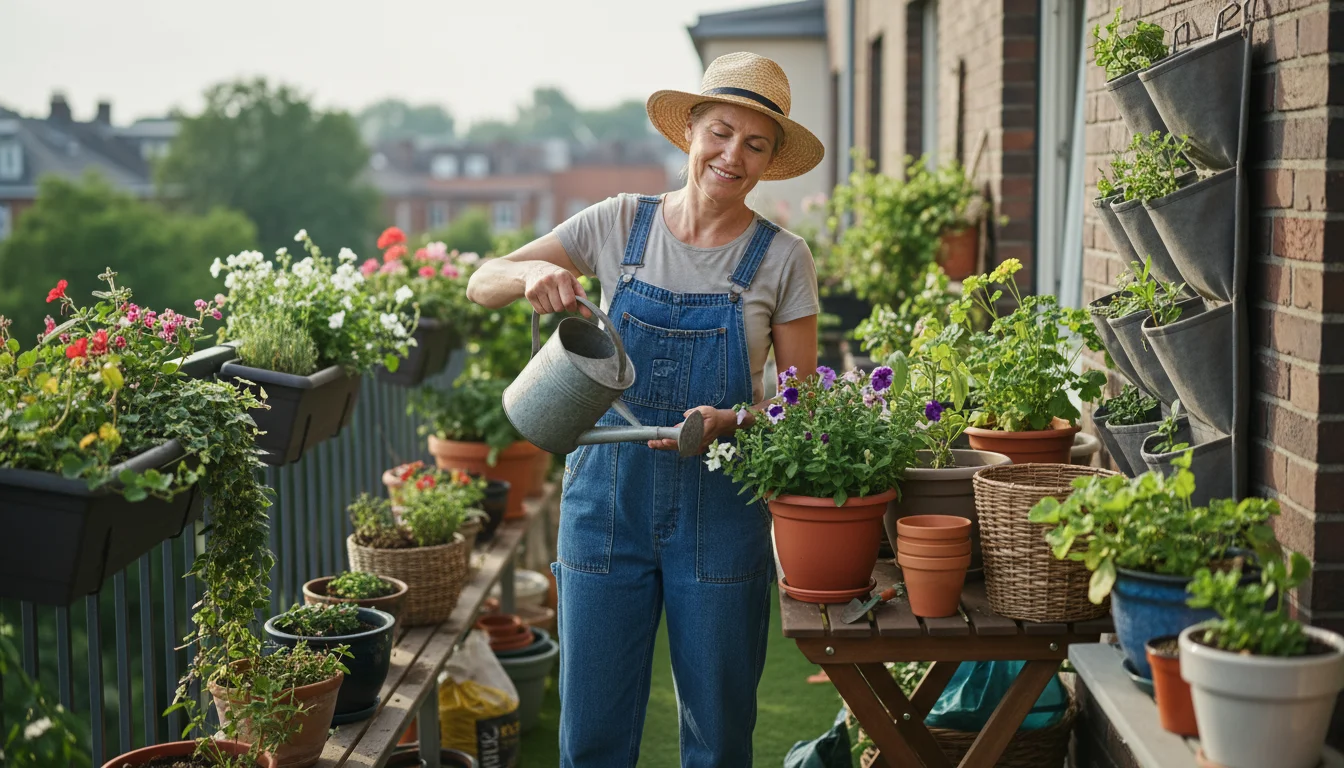
Why Low-Water Gardening Matters in Small Spaces
For gardeners with balconies, patios, or compact yards, conserving water holds particular significance. Smaller spaces often mean gardening in containers, which typically dry out faster than in-ground beds. Restricted root zones and increased exposure to sun and wind exacerbate water loss. By adopting low-water strategies, you:
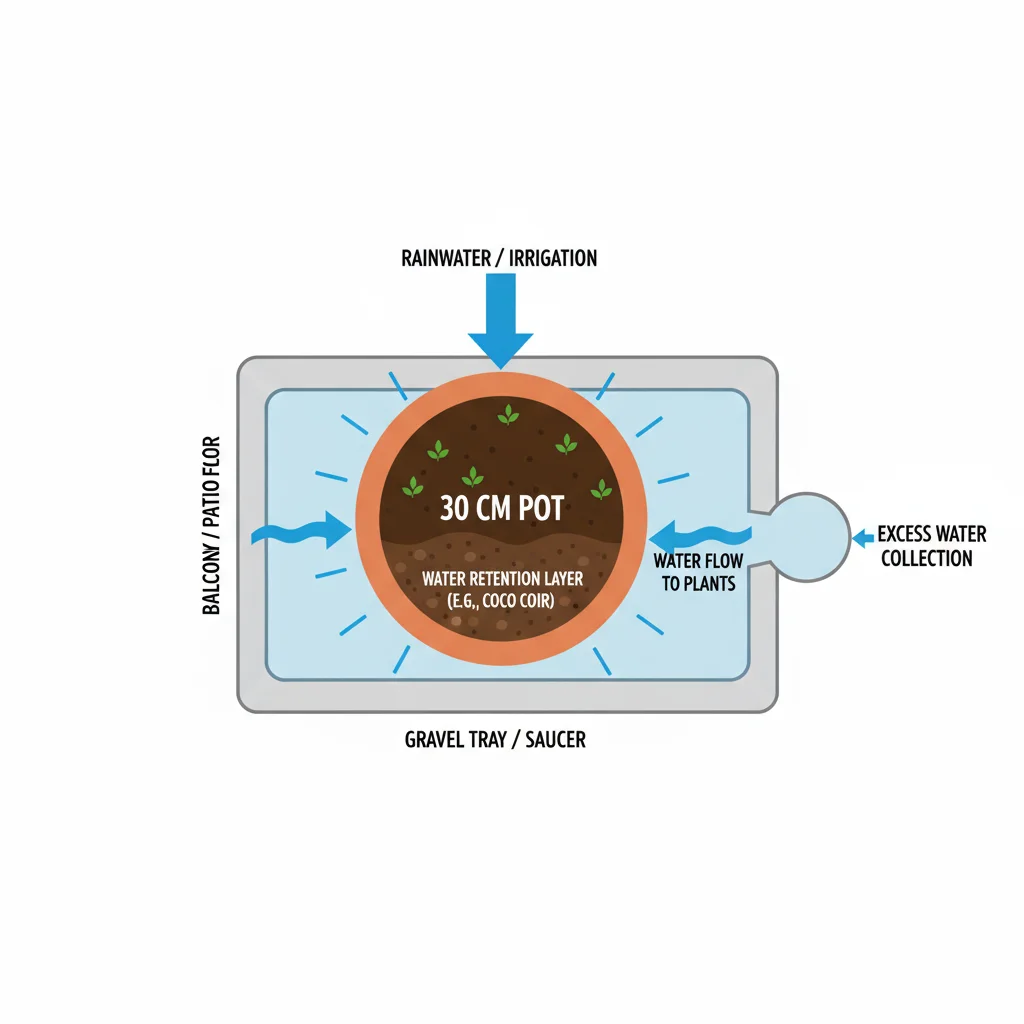
- Reduce Water Bills: Less frequent watering directly translates to lower utility costs. For example, homeowners who convert to xeriscaping can reduce outdoor water use by 50% or more, saving hundreds of dollars annually depending on local water rates.
- Save Time: You spend less time hauling watering cans or tending to irrigation systems, freeing up time to enjoy your garden.
- Boost Plant Health: Many plants, especially those adapted to dry conditions, develop stronger root systems when watered deeply but less often. This promotes resilience against disease and stress.
- Support Local Ecology: Prioritizing native, drought-tolerant plants provides essential habitat and food sources for local pollinators and beneficial insects, even in urban environments.
- Enhance Climate Resilience: Your garden becomes better equipped to withstand periods of drought, heatwaves, and other climate stressors.
By understanding these benefits, you equip yourself with the motivation and knowledge to implement truly sustainable gardening practices.
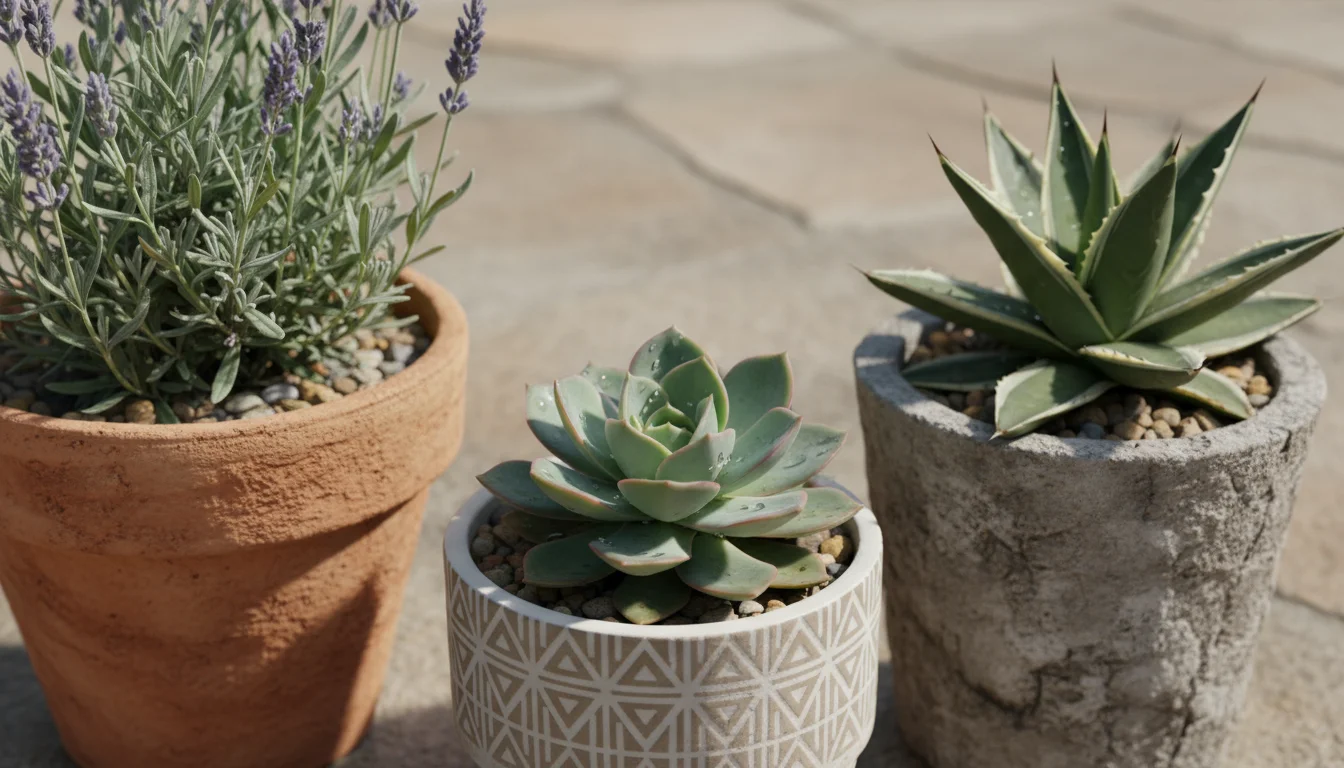
Choosing Drought-Tolerant Plants
The most impactful decision you make for low water gardening involves your plant choices. Selecting plants that naturally thrive in dry conditions minimizes your watering efforts and ensures garden success. These plants typically possess specific adaptations, such as thick, waxy leaves, silvery or hairy foliage, or deep root systems, enabling them to conserve moisture effectively.
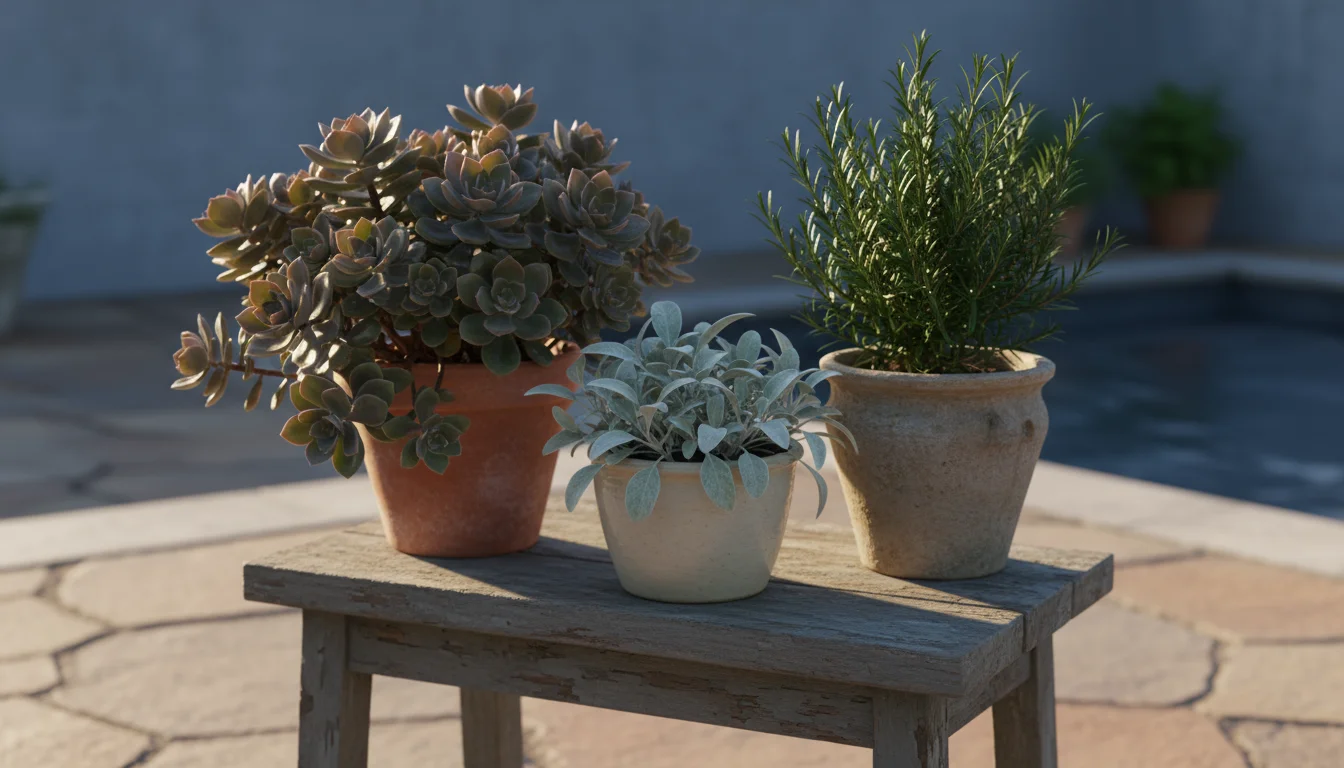
Characteristics of Drought-Tolerant Plants
When selecting plants, look for these natural indicators of water efficiency:
- Succulent or Fleshy Leaves: Plants like sedum, sempervivum, and many aloes store water directly in their leaves.
- Silvery or Hairy Foliage: These features reflect sunlight and reduce transpiration. Examples include lavender, lamb’s ear, and artemisia.
- Small or Narrow Leaves: Less surface area means less water loss. Think rosemary or various ornamental grasses.
- Deep Taproots: Plants like coneflowers or native salvias can access water deep in the soil.
- Waxy Coatings: A thick cuticle on leaves reduces evaporation. Many Mediterranean herbs demonstrate this.
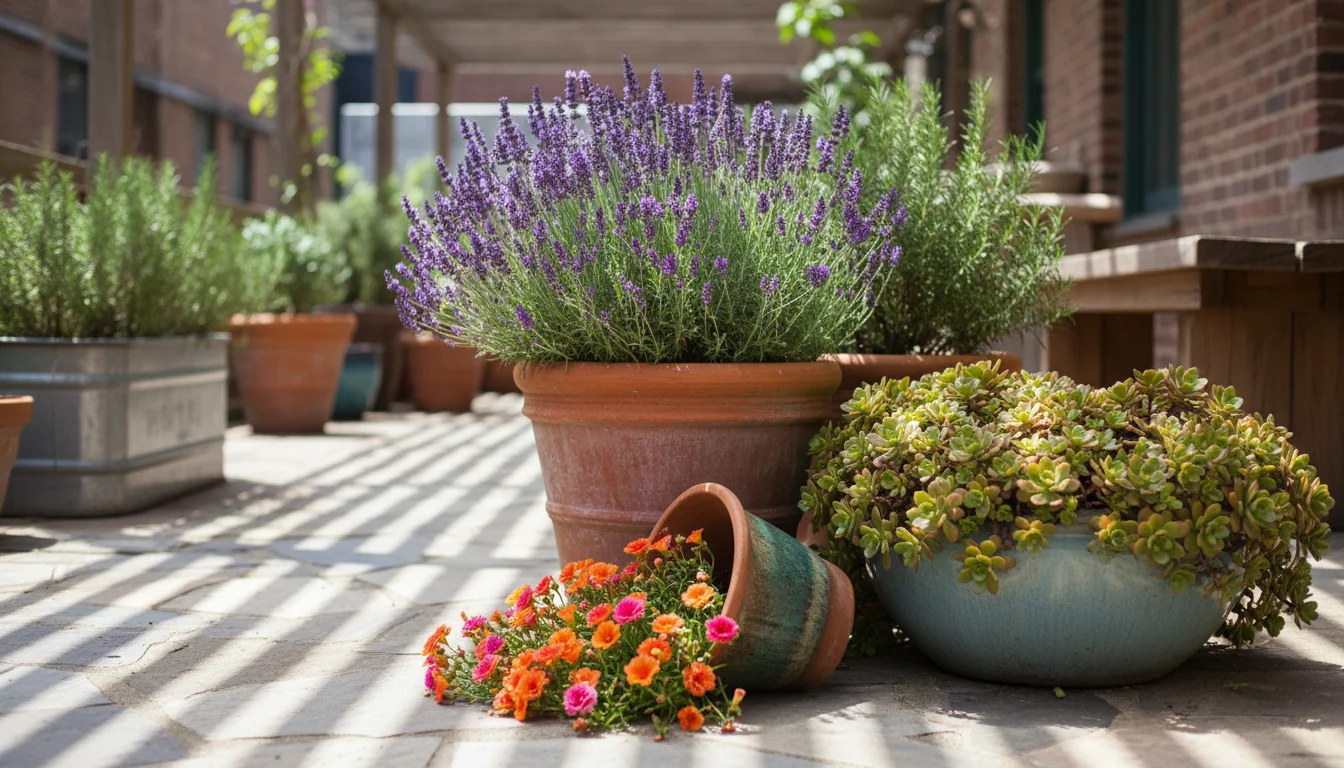
Top Drought Tolerant Container Plants for Small Spaces
Even if you rely primarily on containers, you have a wealth of options for vibrant drought tolerant container plants. Focus on plants that remain compact or tolerate pruning. Always check your USDA hardiness zone to ensure plants suit your climate.
Here are some excellent choices:
| Plant Name | Characteristics & Benefits | Light Needs |
|---|---|---|
| Lavender (Lavandula angustifolia) | Fragrant, purple flowers; attracts bees; silvery foliage for heat reflection. | Full Sun |
| Sedum (Stonecrop) | Succulent leaves, various forms; colorful blooms late season; very low maintenance. | Full Sun to Part Shade |
| Rosemary (Rosmarinus officinalis) | Aromatic herb; needle-like leaves; edible; thrives on neglect. | Full Sun |
| Portulaca (Moss Rose) | Bright, cheerful flowers; succulent foliage; tolerates extreme heat and dryness. | Full Sun |
| Coneflower (Echinacea purpurea) | Native perennial; attracts butterflies and bees; deep roots; long bloom time. | Full Sun |
| Agave | Architectural form; striking foliage; extremely drought tolerant; slow-growing. | Full Sun |
| Yarrow (Achillea millefolium) | Feathery foliage; flat-topped flower clusters; attracts beneficial insects; native in many regions. | Full Sun |
| California Poppy (Eschscholzia californica) | Vibrant orange flowers; self-seeds readily; iconic drought-tolerant annual. | Full Sun |
| Salvia (various species) | Long-blooming spikes of color; attracts hummingbirds and butterflies; many drought-tolerant varieties. | Full Sun |
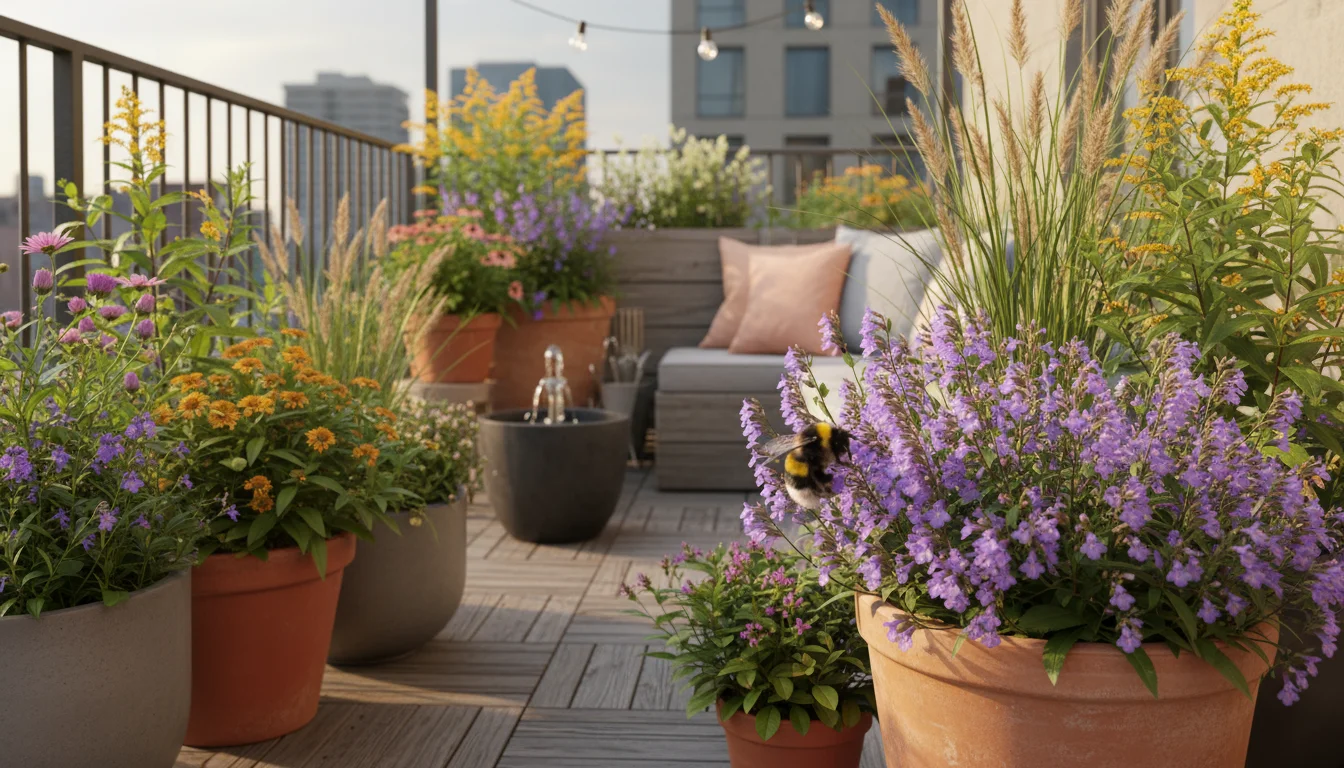
Incorporating Native Plants
Native plants are intrinsically adapted to your local climate, soil conditions, and rainfall patterns, making them ideal for low water gardening. They have evolved to thrive with natural precipitation, often requiring little to no supplemental irrigation once established. Beyond water savings, native plants provide crucial ecological benefits:
- Support Pollinators: They offer specific food and host plants for local insects, bees, and butterflies.
- Reduce Pest Issues: Native plants are often more resistant to local pests and diseases, minimizing the need for interventions.
- Enhance Biodiversity: You contribute to a healthier, more diverse local ecosystem.
Research native plant societies or university extension offices in your region for specific recommendations. For example, in the American Southwest, you might choose plants like desert marigold or brittlebush. In California, manzanita or ceanothus thrive. Many regions have native salvias, asters, and coneflowers suitable for containers.
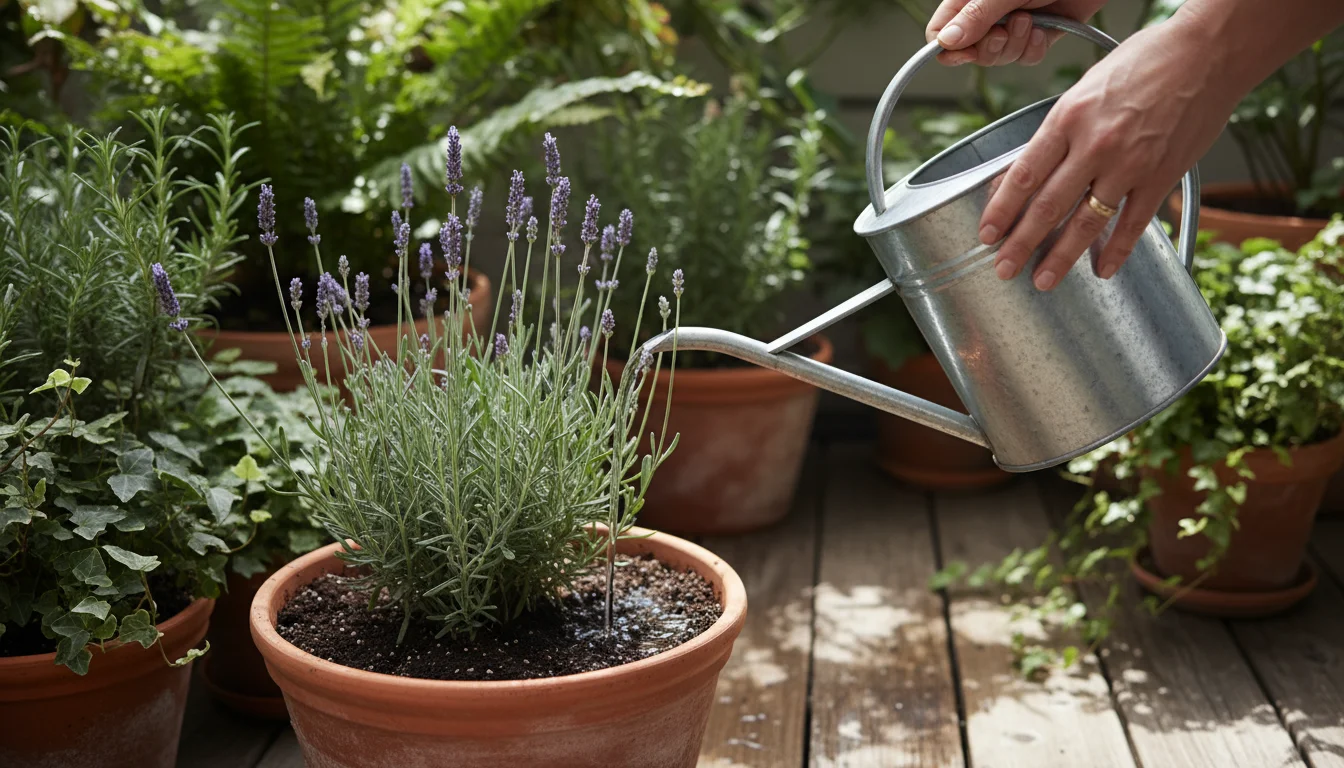
Water-Wise Irrigation Techniques
Even with drought-tolerant plants, responsible watering practices are key. Your goal is to deliver water efficiently to plant roots, minimizing waste from evaporation and runoff. Adopt a “deep and infrequent” watering rhythm, encouraging plants to develop strong, deep root systems.
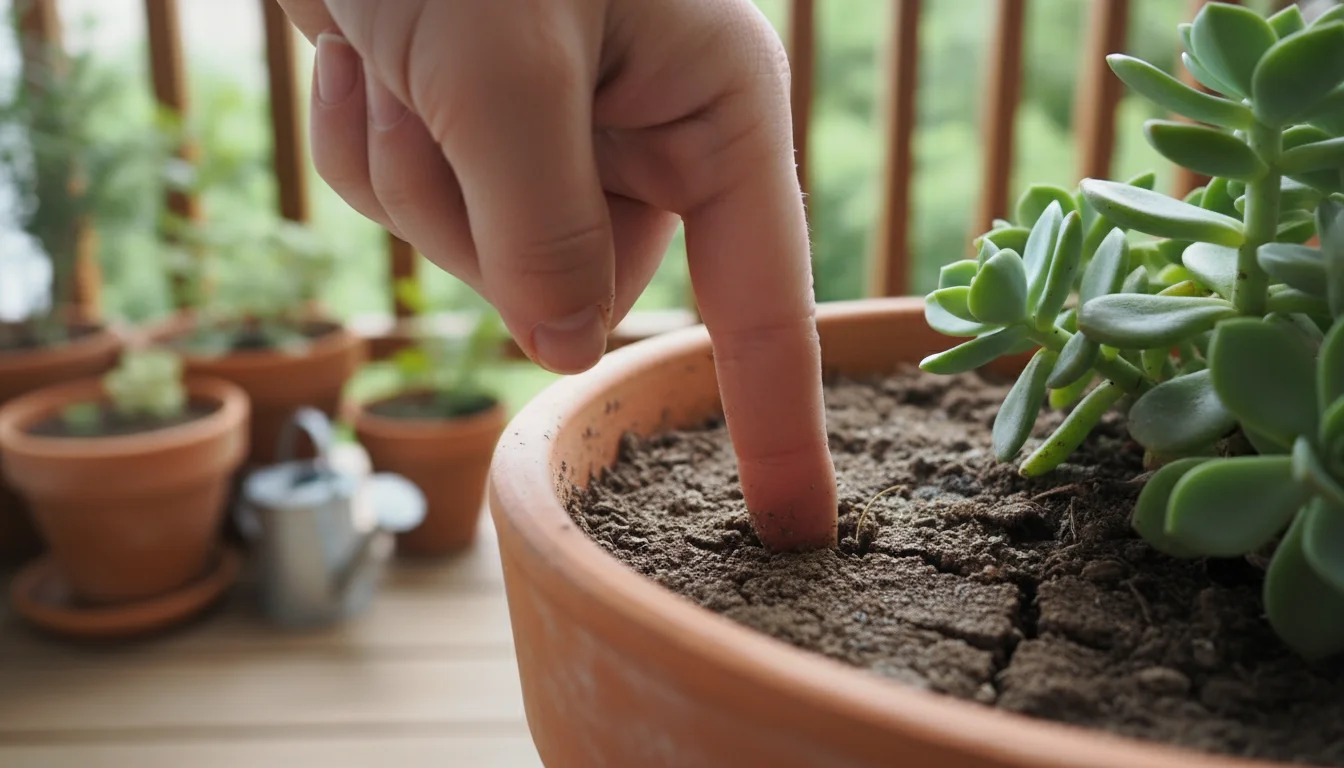
The “Deep and Infrequent” Method
Instead of light, daily sprinkles, you water thoroughly, allowing water to penetrate deep into the soil. Then, you allow the top few inches of soil to dry out before watering again. This pattern mimics natural rainfall, prompts roots to grow deeper in search of moisture, and makes plants more resilient to dry spells.
How to Implement:
- Check Soil Moisture: Stick your finger about 2-3 inches into the soil. If it feels dry, it’s time to water. For containers, lift the pot; if it feels light, it likely needs water. You can also use a moisture meter for accuracy.
- Water Slowly and Deeply: Apply water slowly until you see it drain from the bottom of containers or reach a depth of 6-8 inches in beds. This prevents runoff and ensures even saturation.
- Observe Plants: Learn to recognize signs of thirst. Slight wilting in the heat of the day can be normal, but persistent wilting in the morning indicates stress.
- Adjust Schedule: Factors like plant type, container size, temperature, wind, and sun exposure all influence watering frequency. In intense summer heat, you might water every 2-3 days; in cooler weather, it could be once a week or less.
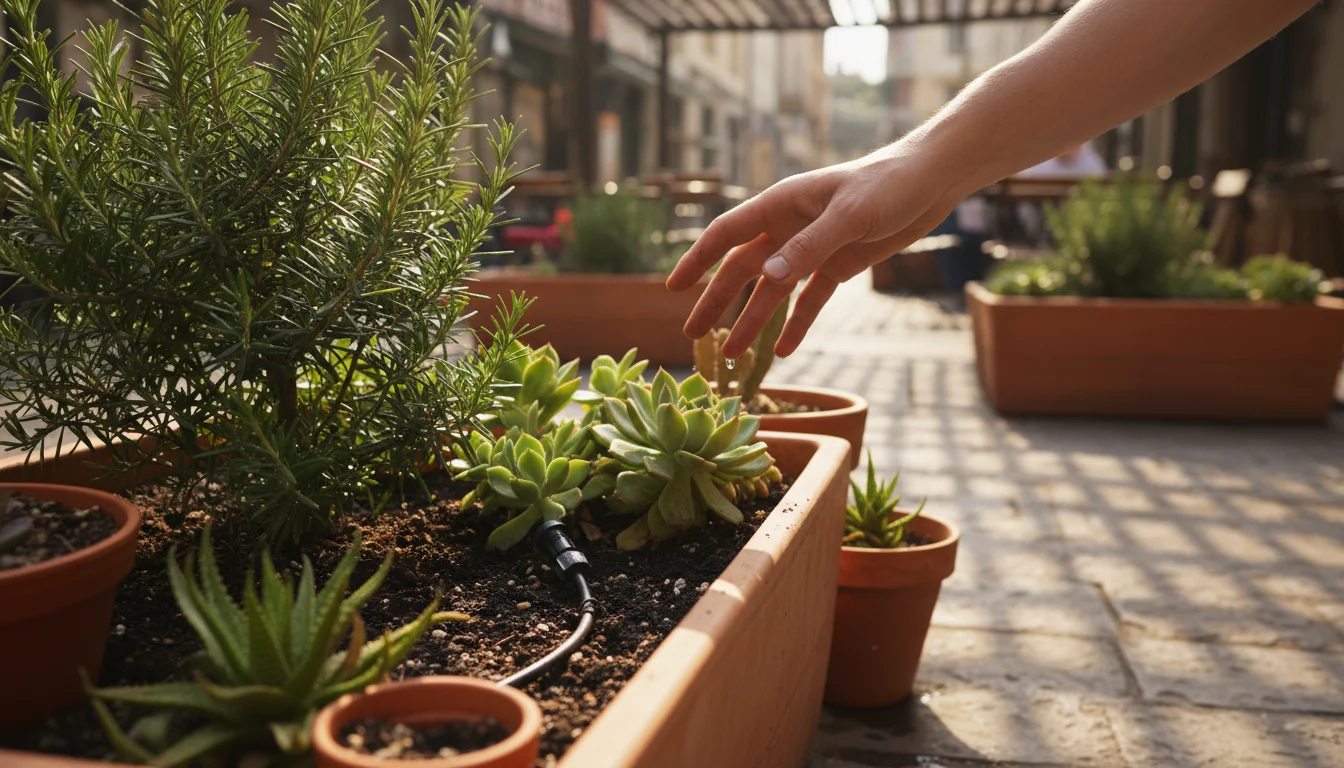
Efficient Watering Tools for Small Spaces
Manual watering often leads to waste. Invest in tools that deliver water precisely where it’s needed.
- Drip Irrigation Systems: These systems deliver water directly to the plant’s root zone through emitters, minimizing evaporation and runoff. Small, customizable drip kits are available for balconies and patios, easily connecting to a standard hose bib. They can reduce water use by 30-50% compared to overhead sprinklers.
- Soaker Hoses: Similar to drip systems, soaker hoses weep water along their entire length. Lay them directly on the soil surface or slightly bury them for optimal efficiency around plant bases.
- Watering Wands: A wand with a gentle shower head allows you to direct water accurately to the base of each plant without splashing leaves or compacting soil.
- Self-Watering or Wicking Containers: These pots feature a reservoir at the bottom and a wicking system that draws water up to the soil as needed. They dramatically reduce watering frequency, making them excellent for vacation care and water conservation. A single reservoir can often keep plants watered for several days to a week.
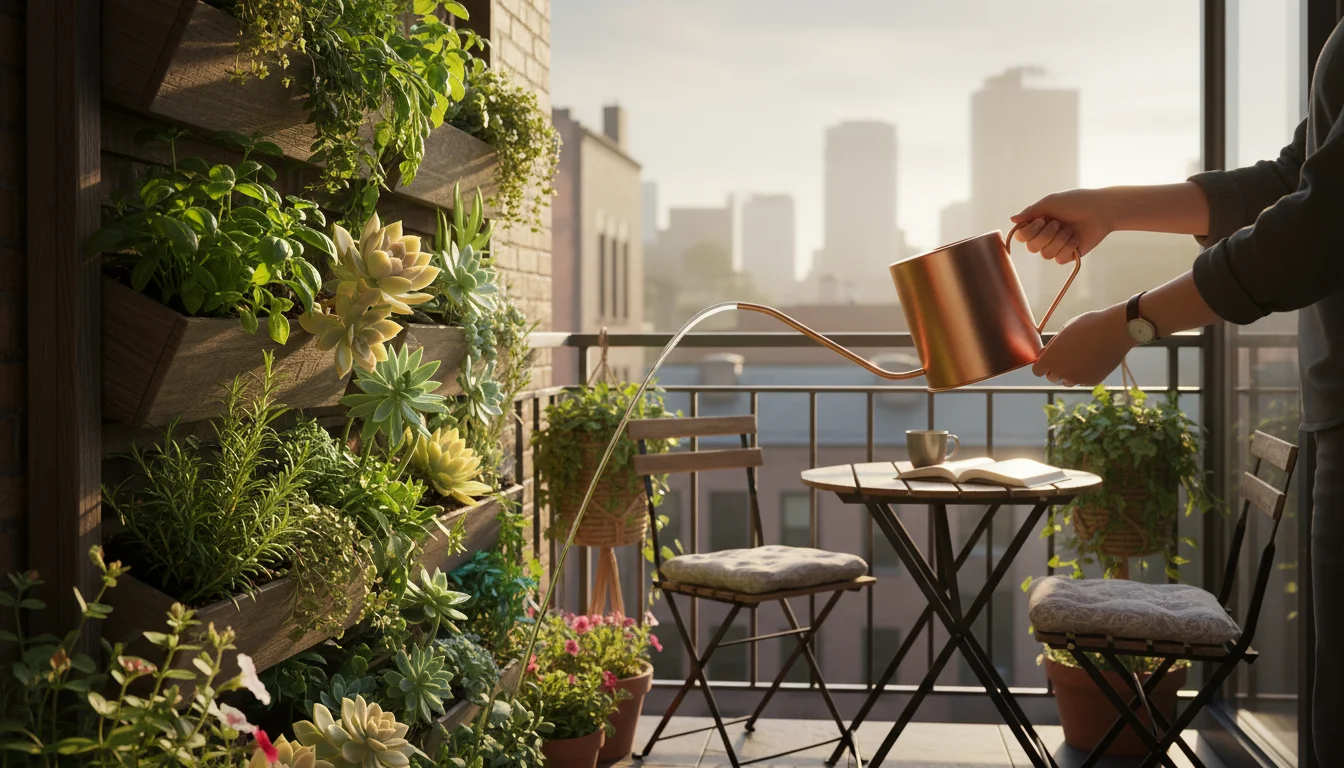
Watering During Peak Heat
Always water in the early morning. This gives plants ample time to absorb moisture before the sun’s intensity increases, reducing water loss through evaporation. Watering in the evening can leave foliage wet overnight, potentially encouraging fungal diseases.
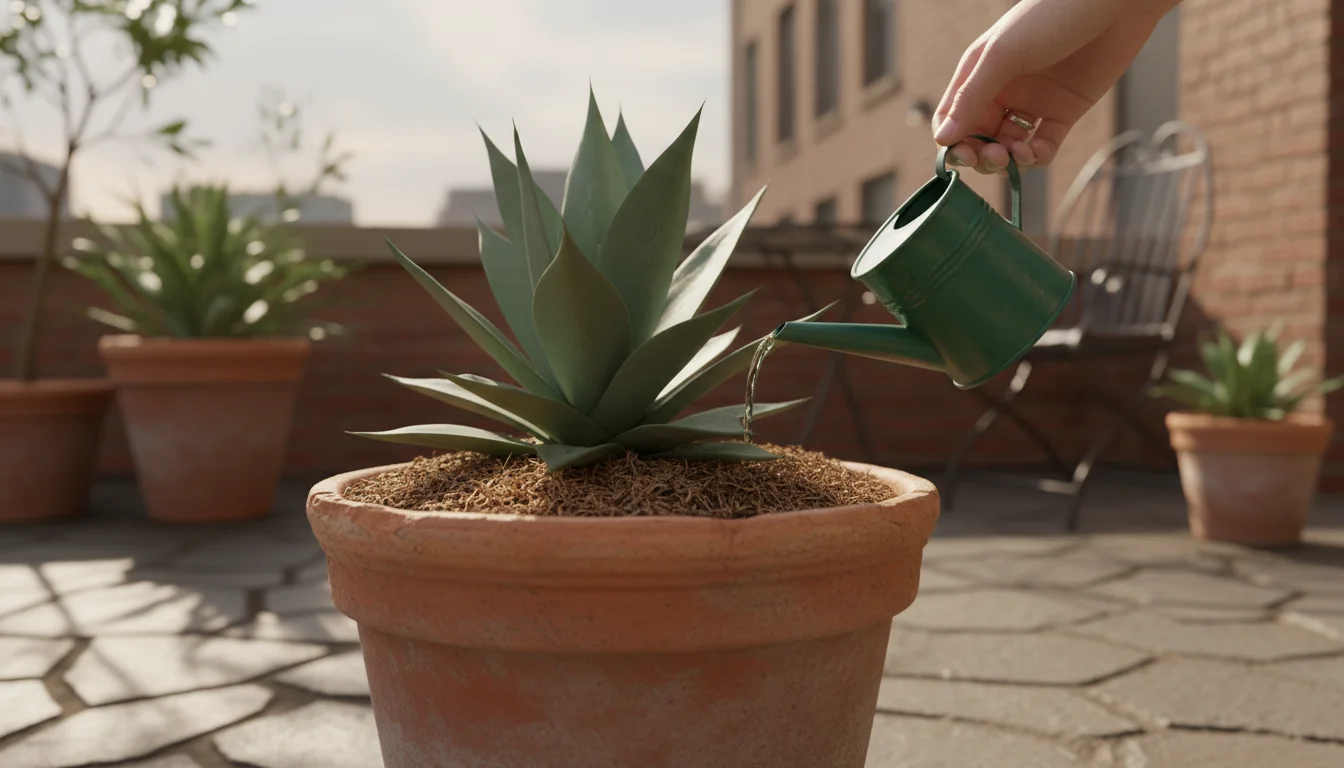
Soil Health and Mulching for Water Retention
Healthy soil acts like a sponge, holding onto moisture and nutrients, making it central to successful low water gardening. Improving soil structure directly translates to less frequent watering, especially in compact gardens and containers.
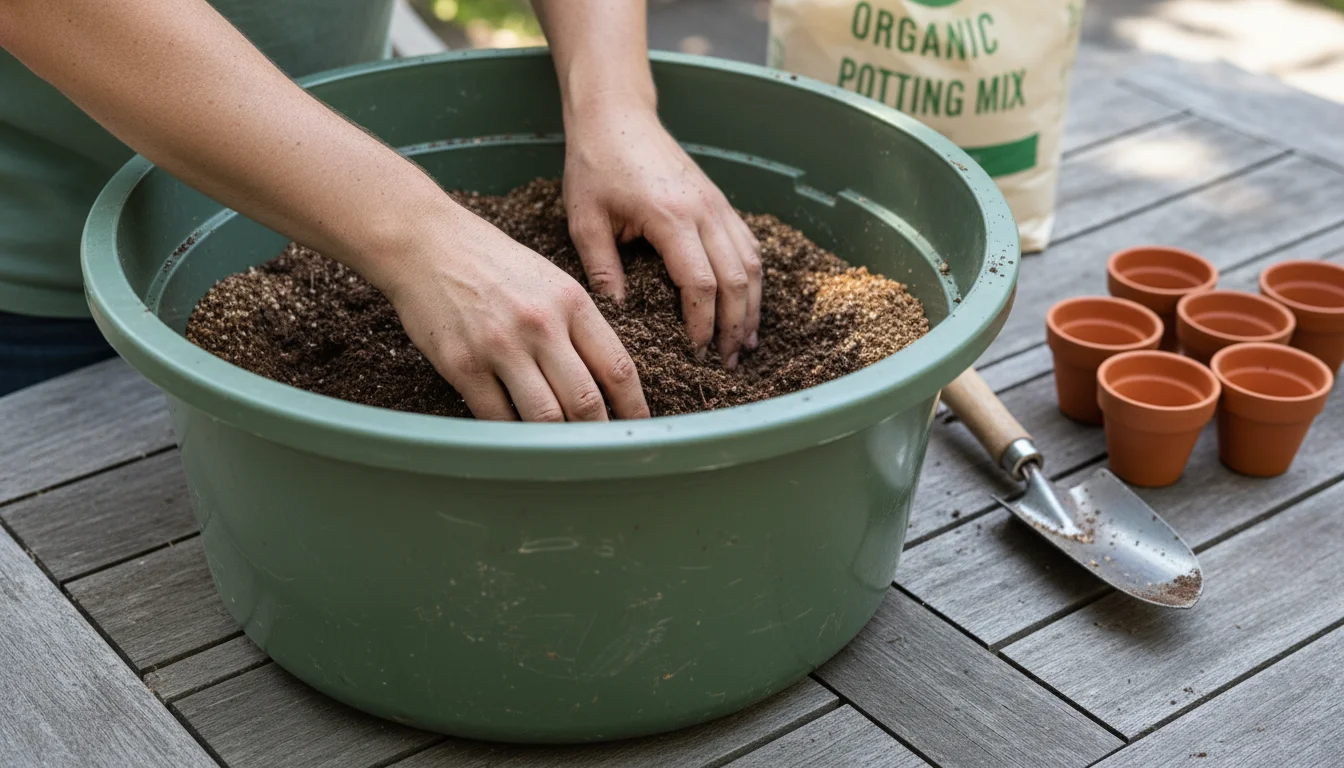
The Role of Organic Matter
Organic matter, such as compost or well-rotted manure, is your best ally for water retention. When you incorporate organic matter into your soil, it:
- Increases Water Holding Capacity: Organic particles bind with water molecules, holding moisture in the root zone. Every 1% increase in soil organic matter can increase the soil’s water holding capacity by 25,000 gallons per acre.
- Improves Drainage: Paradoxically, organic matter also improves drainage in heavy clay soils by creating larger pore spaces, preventing waterlogging.
- Enhances Nutrient Availability: It provides a slow release of essential nutrients, fostering stronger plant growth and deeper root systems.
- Supports Microorganisms: Organic matter feeds beneficial soil microbes, which are vital for a healthy, living soil ecosystem.
For container gardens, use a high-quality, peat-free potting mix that contains coir, compost, or other organic amendments. Avoid mixes with large amounts of perlite or vermiculite unless specifically aiming for very fast drainage; these can reduce water retention.
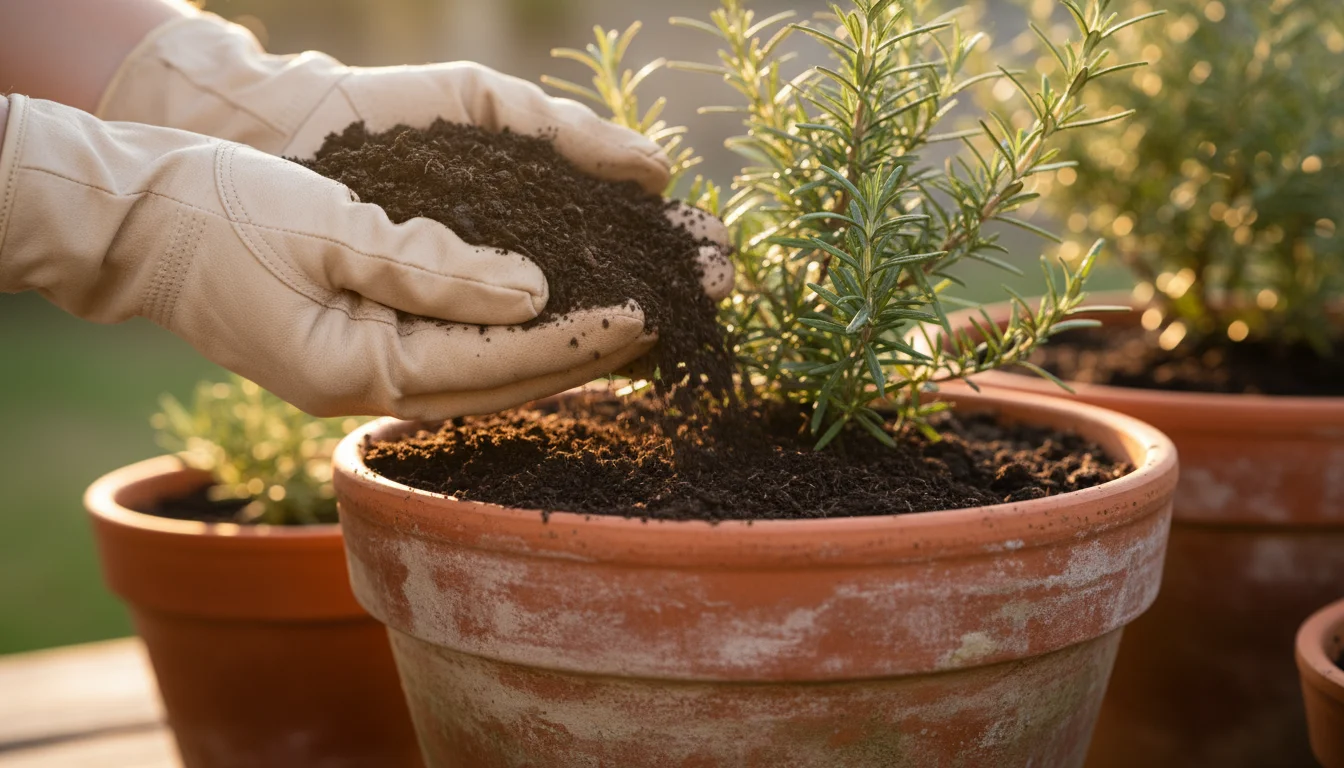
The Power of Mulch
Mulching is a simple yet incredibly effective strategy for water conservation. A layer of mulch on top of your soil or potting mix acts as a protective barrier, reducing evaporation and keeping soil temperatures stable.
Benefits of Mulching:
- Reduces Evaporation: Mulch can reduce water evaporation from the soil surface by 10-50%, meaning you water less often.
- Suppresses Weeds: Weeds compete with your plants for water and nutrients. Mulch smothers weed seeds, reducing their growth.
- Moderates Soil Temperature: It keeps soil cooler in summer and warmer in winter, reducing stress on plant roots.
- Prevents Soil Erosion: Mulch protects the soil from heavy rain and wind.
- Adds Organic Matter: Organic mulches break down over time, enriching the soil.
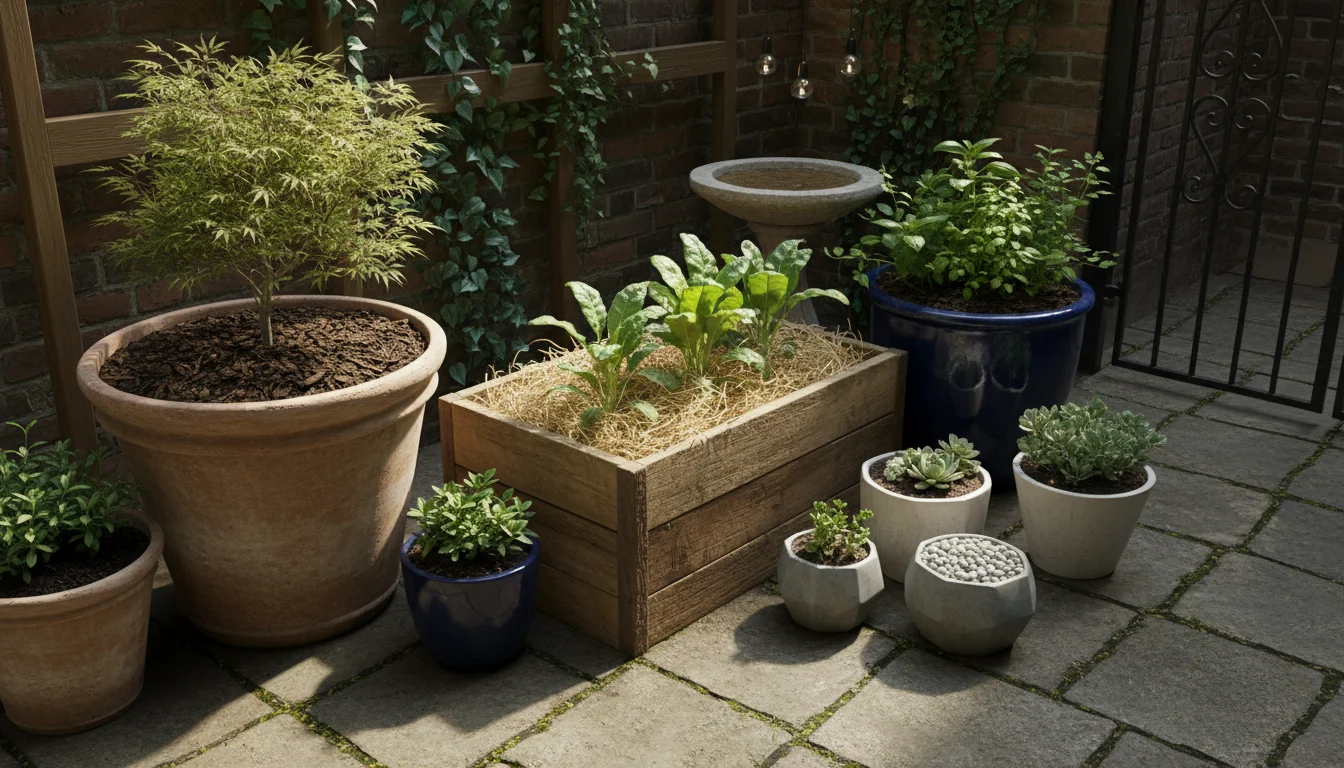
Choosing the Right Mulch for Small Spaces
The best mulch for your small garden depends on your specific needs and aesthetic preferences. Apply a layer 2-4 inches deep, keeping it a few inches away from plant stems to prevent rot.
- Wood Chips or Shredded Bark: Excellent for larger containers and raised beds. They break down slowly, provide long-term benefits, and offer an attractive, natural look.
- Straw: Ideal for vegetable gardens. It’s inexpensive, decomposes quickly, and adds organic matter. Ensure it is herbicide-free.
- Compost: A fantastic organic mulch that directly feeds your soil as it breaks down. Use a finer, finished compost.
- Pebbles or Gravel: Good for succulents and plants that prefer very dry conditions, as they prevent moisture from lingering around the plant base. They do not add organic matter.
- Leaf Mold: Decomposed leaves create a nutrient-rich, moisture-retaining mulch. Gather fallen leaves in autumn and let them break down.
Avoid using plastic sheeting as mulch; it can trap heat, reduce air circulation, and harm soil biology. Always opt for natural, breathable options.
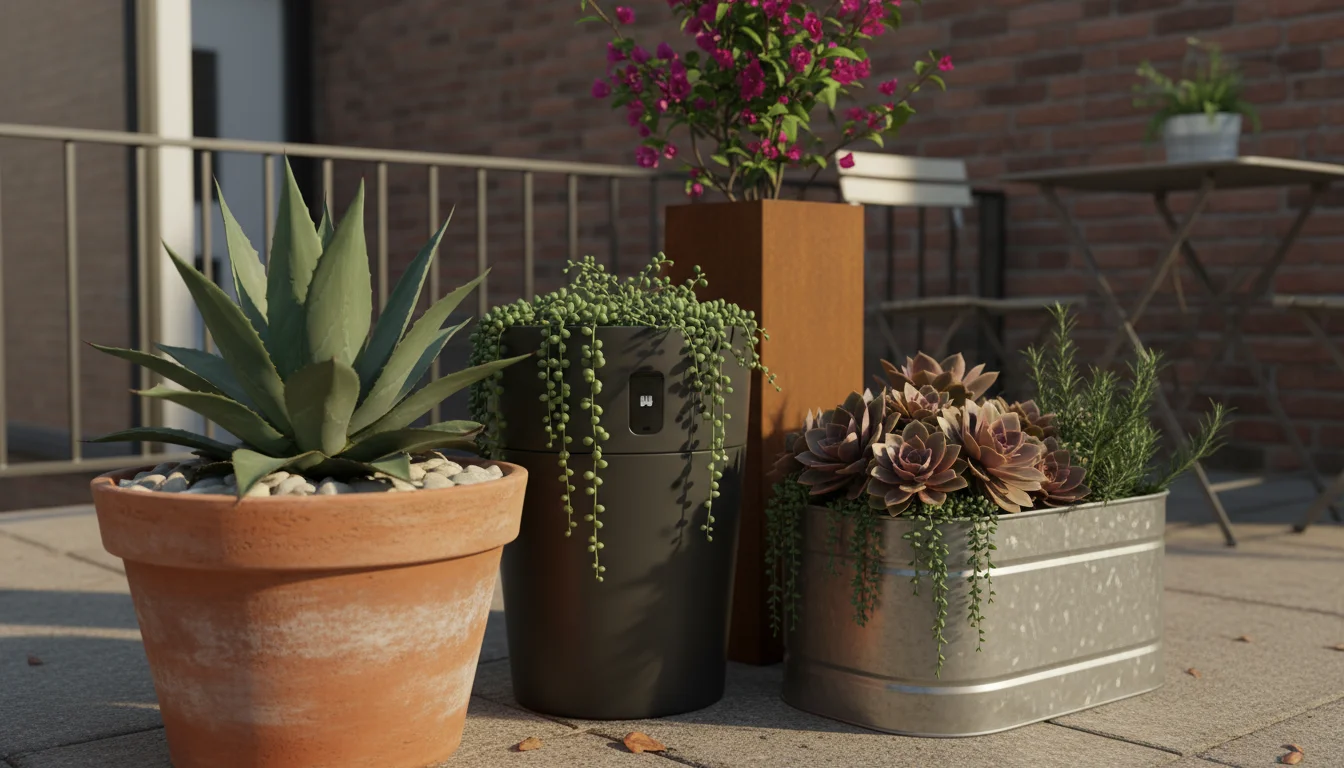
Container Gardening Strategies for Drought
Container gardening presents unique challenges for water retention, as pots heat up faster and dry out more quickly than in-ground beds. However, with smart strategies, your potted plants can thrive in drought-prone conditions.
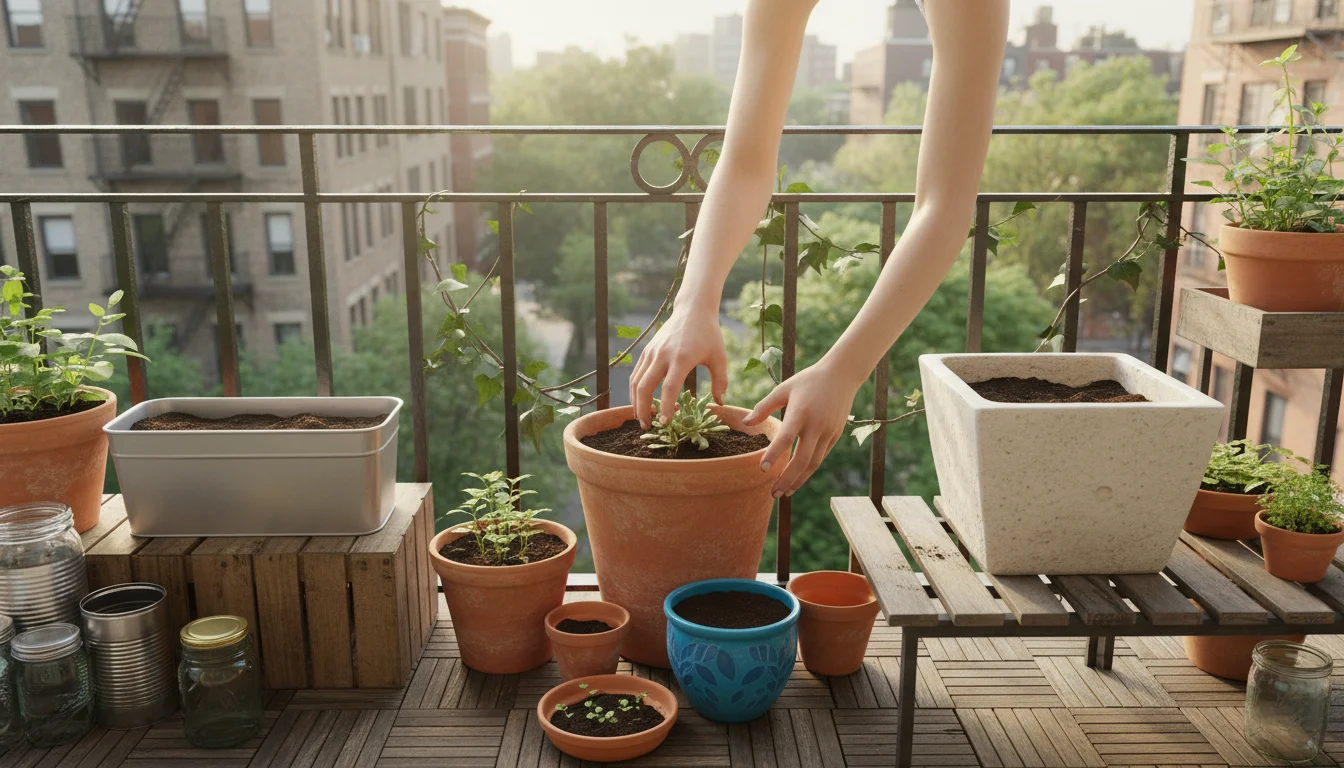
Selecting the Right Containers
Your container choice significantly impacts water needs:
- Material Matters:
- Unglazed Terracotta: Porous, allowing water to evaporate through the sides, which can be detrimental in dry climates. If you love the look, consider sealing the inside or using it as a cachepot for a plastic pot.
- Glazed Ceramic, Plastic, Metal: These materials retain moisture better, making them superior for low-water gardening. Darker colors absorb more heat, potentially drying out soil faster. Lighter colors reflect heat.
- Fabric Grow Bags: Offer excellent drainage and air pruning for roots, but their porous nature means they dry out very quickly in hot, dry conditions. They are best for short-term crops or when you can commit to more frequent watering.
- Size: Opt for the largest containers your space and plants allow. Larger soil volume means more water retention and a more stable root environment. A 10-gallon container will require significantly less frequent watering than a 1-gallon pot.
- Drainage Holes: Always ensure your containers have adequate drainage holes to prevent waterlogging, which can lead to root rot.
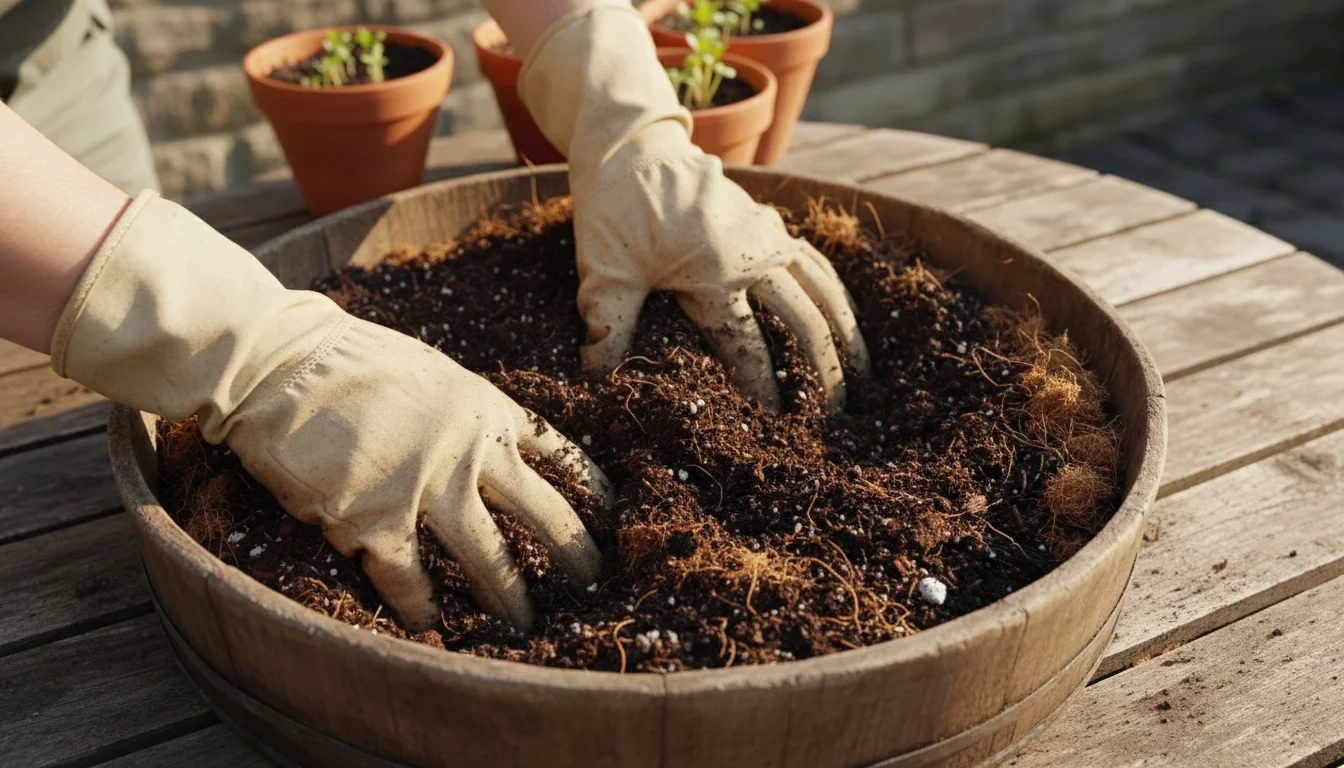
Enhancing Container Water Retention
Even with the right containers, you can take further steps to keep your potted plants hydrated:
- Add Water-Retaining Amendments:
- Coconut Coir: An excellent peat-free alternative, coir holds up to 10 times its weight in water and rehydrates easily when dry. Mix 20-30% coir into your potting mix.
- Compost: Incorporating finished compost into your potting mix significantly boosts its water-holding capacity and provides slow-release nutrients. Aim for 10-20% compost.
- Perlite or Vermiculite: While these improve drainage, vermiculite also absorbs water, making it a good addition for moisture retention if used in moderation (5-10%).
- Mulch Containers: Apply a 1-2 inch layer of mulch (shredded bark, small pebbles, or compost) to the top of your container soil. This reduces surface evaporation by up to 30%.
- Group Containers: Cluster your pots together. This creates a microclimate where plants shade each other, and the combined transpiration increases local humidity, reducing individual water loss.
- Use Saucers: Place saucers under your pots to catch excess water. Allow plants to reabsorb this water over a few hours, but empty any remaining water to prevent mosquitoes and root rot.
- Shade Cloth or Relocation: During peak summer heat, move containers to a shadier spot or use shade cloth to protect them from intense afternoon sun, which can reduce water needs by as much as 25%.
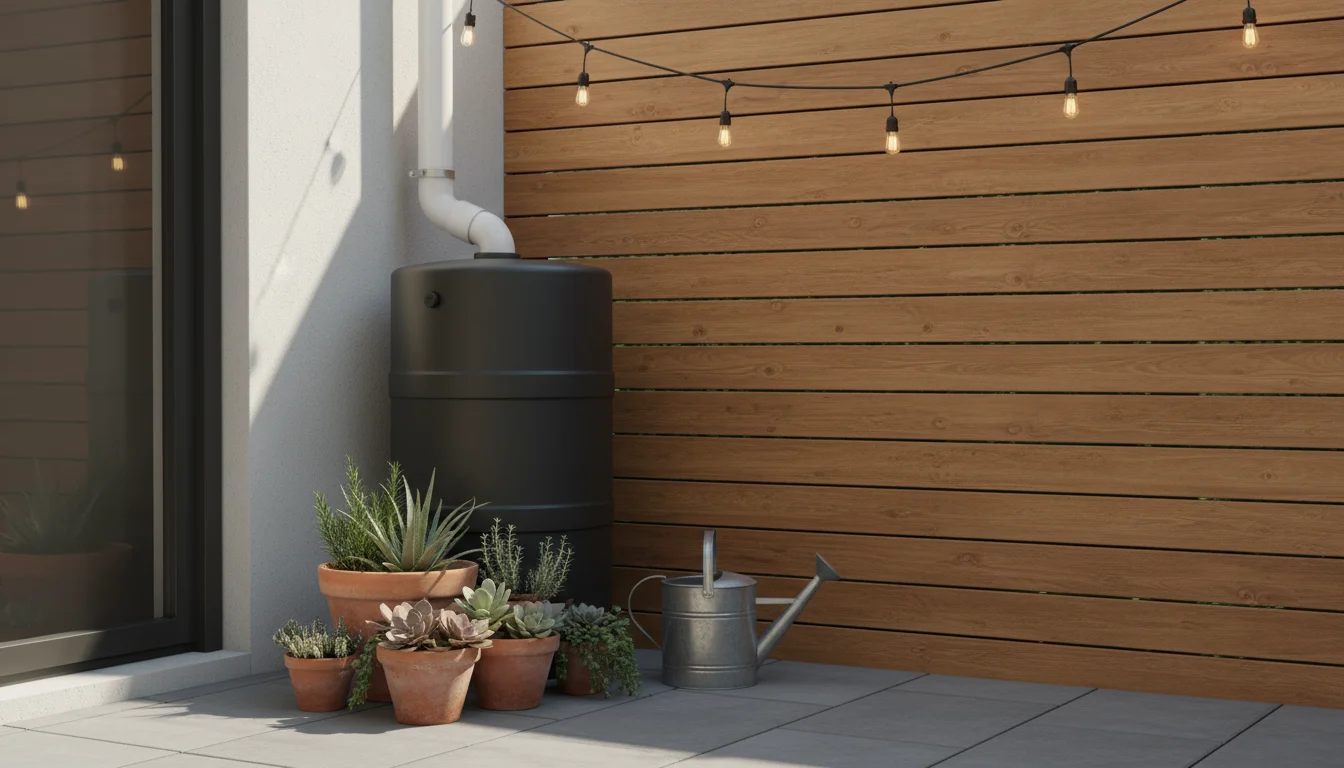
Rain Capture and Greywater Systems
Maximizing every drop of water means not only using it efficiently but also collecting and reusing it. Rainwater harvesting and greywater systems offer advanced solutions for low water gardening, especially impactful in drought-prone regions.
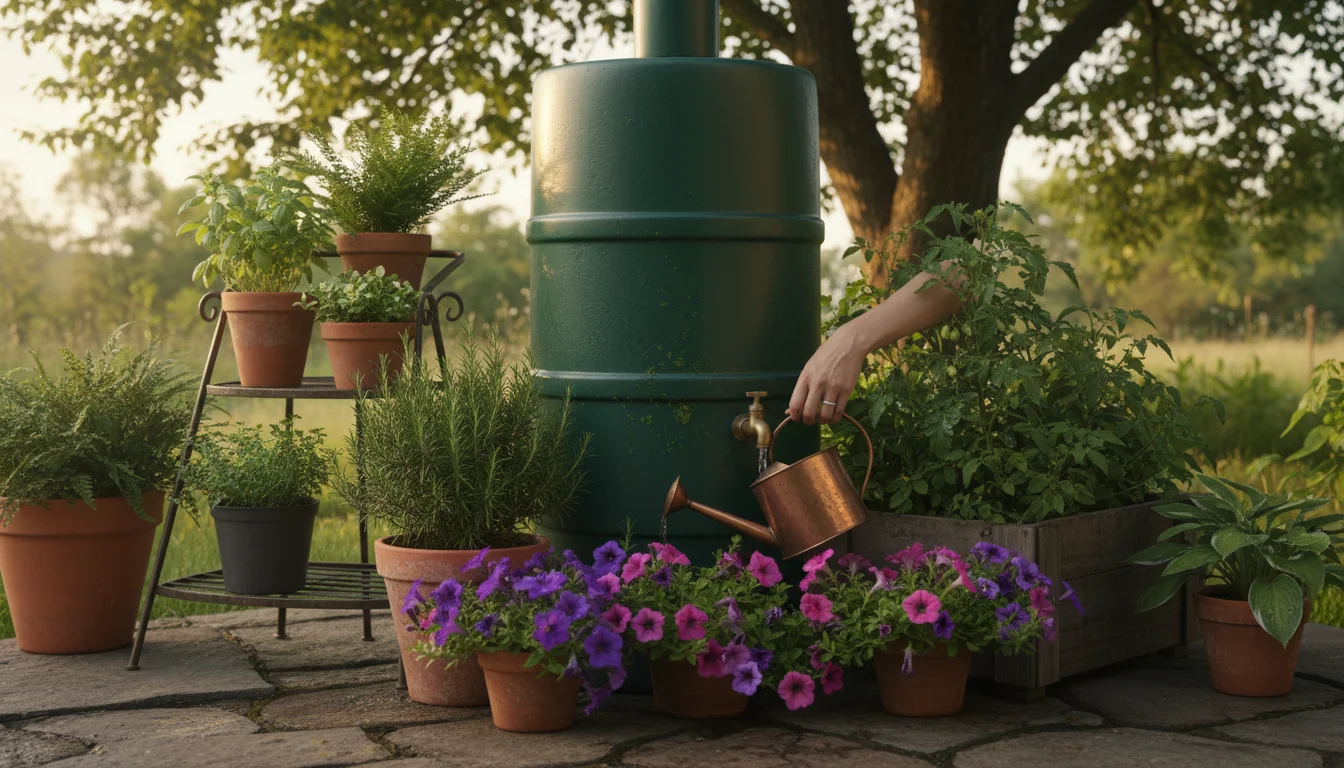
Rainwater Harvesting with Rain Barrels
Rain barrels are simple devices that collect rainwater from your roof via downspouts. This water is excellent for plants because it lacks chlorine, fluoride, and other chemicals found in municipal tap water. Installing a rain barrel is a straightforward project suitable for many small spaces.
Benefits of Rainwater:
- Chemical-Free Water: Healthier for plants and soil microorganisms.
- Reduced Runoff: Lessens the burden on storm drains, preventing erosion and pollution.
- Lower Water Bills: Provides a free source of irrigation water.
- Drought Resilience: Builds a reserve for dry spells.
Setting Up a Rain Barrel:
- Choose a Location: Place your barrel near a downspout, on a stable, level surface capable of supporting its weight when full (a 50-gallon barrel can weigh over 400 pounds).
- Prepare the Downspout: You typically need to cut your downspout and install a diverter kit. This directs water into the barrel when it rains and allows overflow to continue down the downspout when the barrel is full.
- Elevate the Barrel: Place the barrel on concrete blocks or a sturdy stand to provide enough height for gravity to create pressure, allowing you to fill watering cans or connect a soaker hose.
- Install Screen and Spigot: Ensure the barrel has a fine mesh screen over the inlet to keep out debris and insects. Install a spigot at the bottom for easy access. An overflow hose directs excess water away from your foundation.
- Check Local Regulations: Always verify local ordinances regarding rainwater harvesting. Some areas have specific rules or incentives.
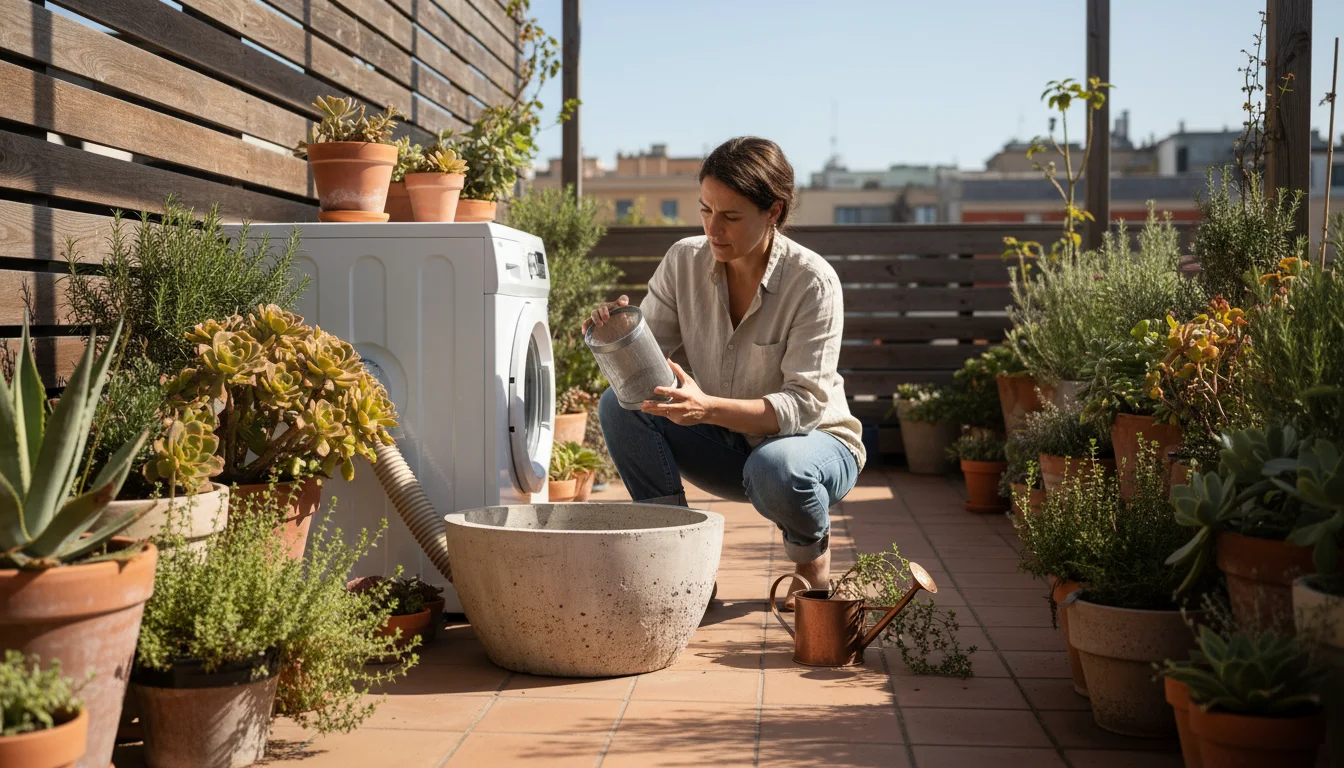
Understanding Greywater Systems
Greywater refers to lightly used water from sinks, showers, bathtubs, and washing machines. It excludes water from toilets (blackwater) or kitchen sinks (which can contain grease and food particles). Reusing greywater in your garden dramatically reduces your potable water consumption, especially during droughts.
Key Considerations for Greywater:
- Local Regulations: Greywater systems often have strict local regulations. Always consult your municipality or health department before planning any installation. Improper installation can pose health risks or incur fines.
- Soap and Detergent Choice: Use biodegradable, plant-friendly soaps and detergents. Avoid products containing chlorine bleach, boron, sodium perborate, or synthetic dyes and fragrances, as these can harm plants and soil microbes. Look for “greywater-safe” or “biodegradable” labels.
- Application Methods: Greywater is typically applied below the soil surface to prevent human and pet contact and reduce pathogen exposure. Simple systems might involve directing shower water directly to a thirsty tree or garden bed. More complex systems filter and distribute water.
- Plant Compatibility: While most ornamental plants tolerate greywater, apply it to non-edible plants or fruit trees. Avoid directly watering leafy greens or root vegetables you will eat, to minimize contact with any residual contaminants.
- Filtration: Even simple systems benefit from a basic filter to remove hair and lint, preventing clogs.
While installing a full greywater system might be complex for a small-space beginner, you can start with simple, non-plumbed methods like collecting shower warm-up water in a bucket and using it to water containers. Every gallon saved makes a difference.
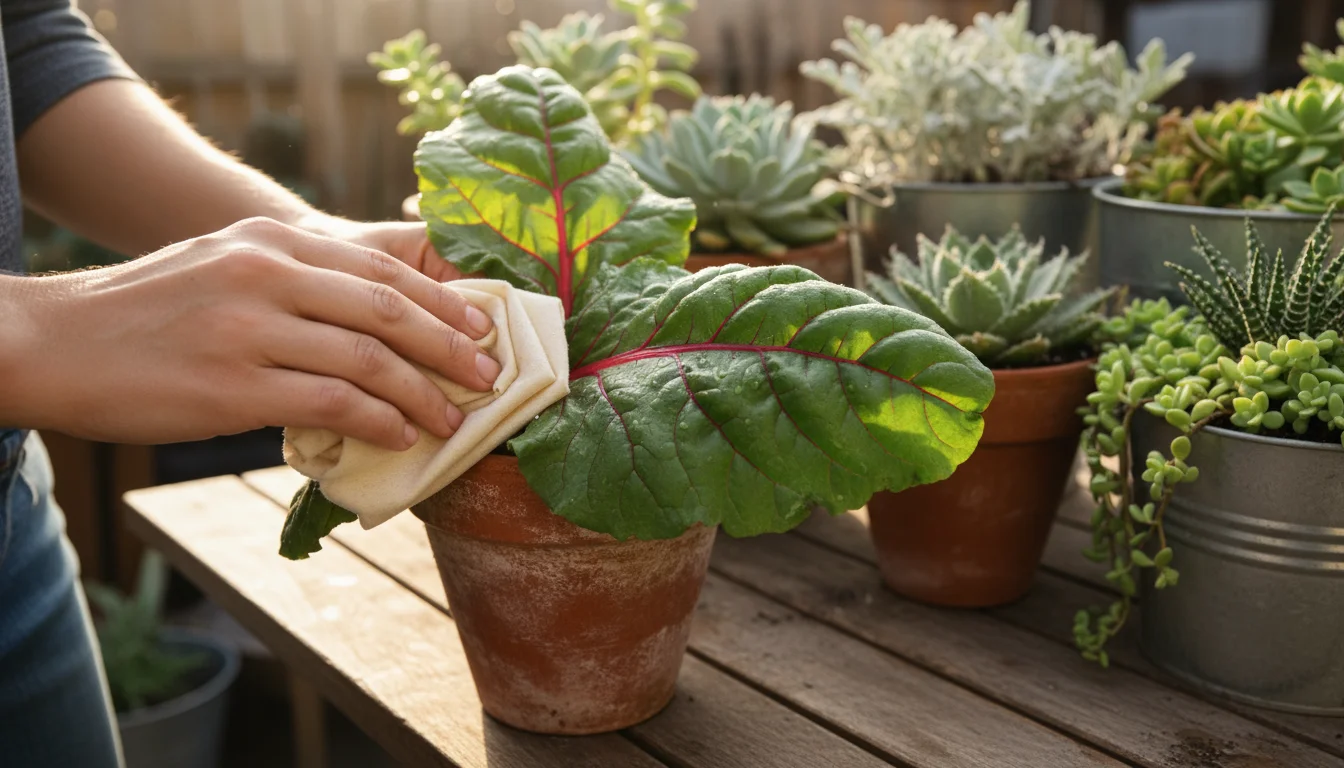
Pest Management in a Dry Climate
Drought conditions can stress plants, making them more susceptible to pests and diseases. Conversely, some pests thrive in dry, dusty environments. Implementing Integrated Pest Management (IPM) principles ensures you manage pests effectively and sustainably without relying on harmful chemicals, which is crucial for a low-impact garden.
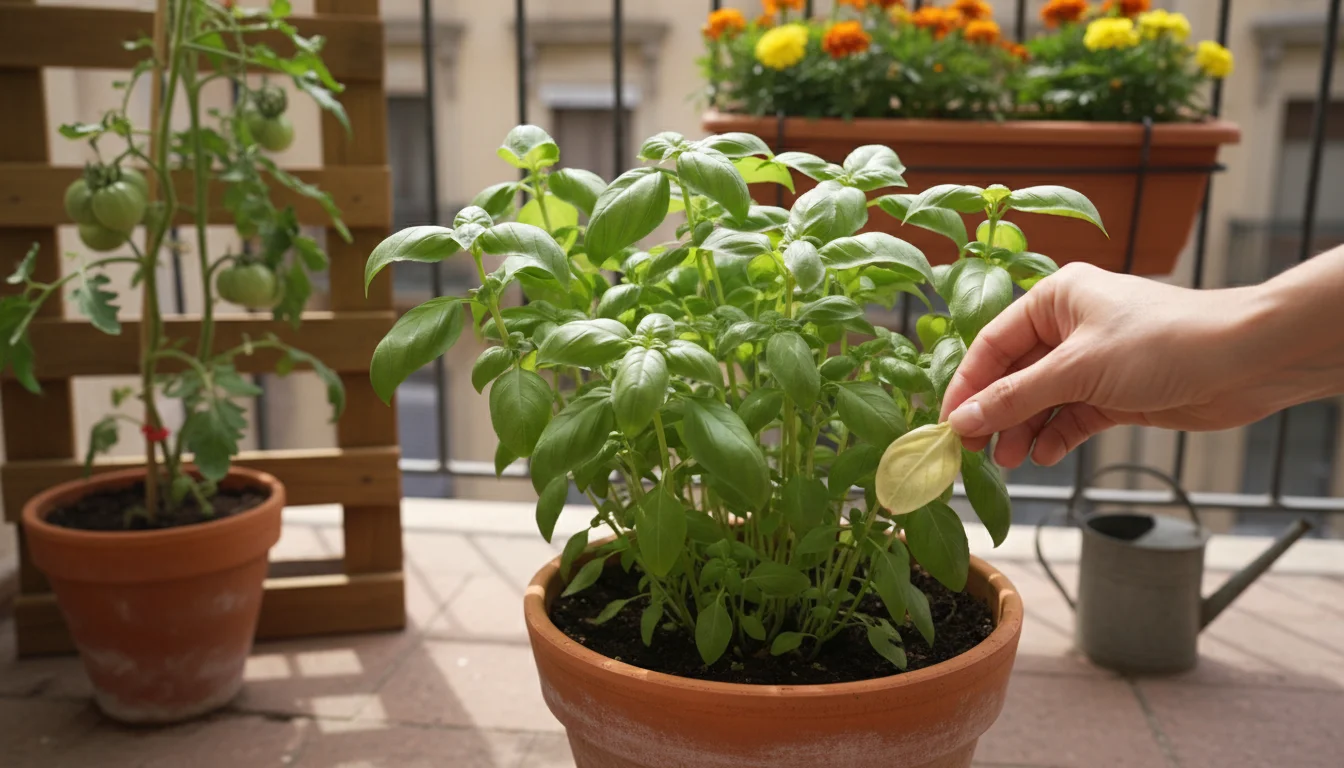
Integrated Pest Management (IPM) Principles
IPM is a holistic approach that prioritizes prevention and observation. You use a combination of strategies to minimize pest damage, resorting to the least toxic options only when necessary.
- Prevention:
- Choose Healthy Plants: Select disease and pest-resistant varieties. Healthy plants are naturally more resilient.
- Ensure Proper Plant Spacing: Good air circulation reduces fungal issues and makes plants less attractive to some pests.
- Maintain Soil Health: Robust soil supports strong, healthy plants that can better resist pest attacks.
- Water Correctly: Under or overwatering stresses plants, making them vulnerable. Refer to the “deep and infrequent” method.
- Sanitation: Remove diseased plant material and fallen leaves promptly to prevent pest and disease spread. Clean your tools regularly.
- Monitoring:
- Regular Inspections: Frequently inspect your plants, especially the undersides of leaves and new growth. Early detection prevents minor issues from becoming major infestations.
- Identify Pests: Know your enemies. Learn to identify common pests in your region and understand their life cycles. This helps you choose the most effective control methods.
- Understand Damage: Distinguish between pest damage, nutrient deficiencies, or environmental stress.
- Mechanical/Physical Controls:
- Hand-Picking: For larger pests like slugs or caterpillars, simply pick them off and dispose of them.
- Strong Water Spray: A strong jet of water can dislodge aphids, spider mites, and whiteflies from leaves.
- Pruning: Remove heavily infested branches or leaves to reduce pest populations.
- Barriers: Use floating row covers to protect young plants from flying insects. Copper tape can deter slugs and snails.
- Biological Controls:
- Attract Beneficial Insects: Plant flowers that provide nectar and pollen for predatory insects like ladybugs, lacewings, and hoverflies. These natural predators feast on common garden pests.
- Purchase Beneficials: In some cases, you can release beneficial insects into your garden, though this is often more effective in enclosed spaces or larger gardens.
- Least-Toxic Chemical Controls (Last Resort):
- Insecticidal Soaps: Effective against soft-bodied insects like aphids and spider mites. They work by smothering the pests.
- Neem Oil: A botanical insecticide that disrupts insect feeding and growth. It’s effective against a broad range of pests.
- Horticultural Oils: Work similarly to insecticidal soaps, coating and suffocating pests.
Always follow product instructions carefully when using any spray. Apply in the early morning or late evening to avoid harming beneficial insects, which are less active then, and to prevent leaf burn in strong sunlight.
In dry climates, spider mites are often a problem because they thrive in dusty, low-humidity conditions. Regular rinsing of plant foliage with water can help deter them. Ensure good air circulation and avoid over-fertilizing, which can promote lush, soft growth that is attractive to pests.
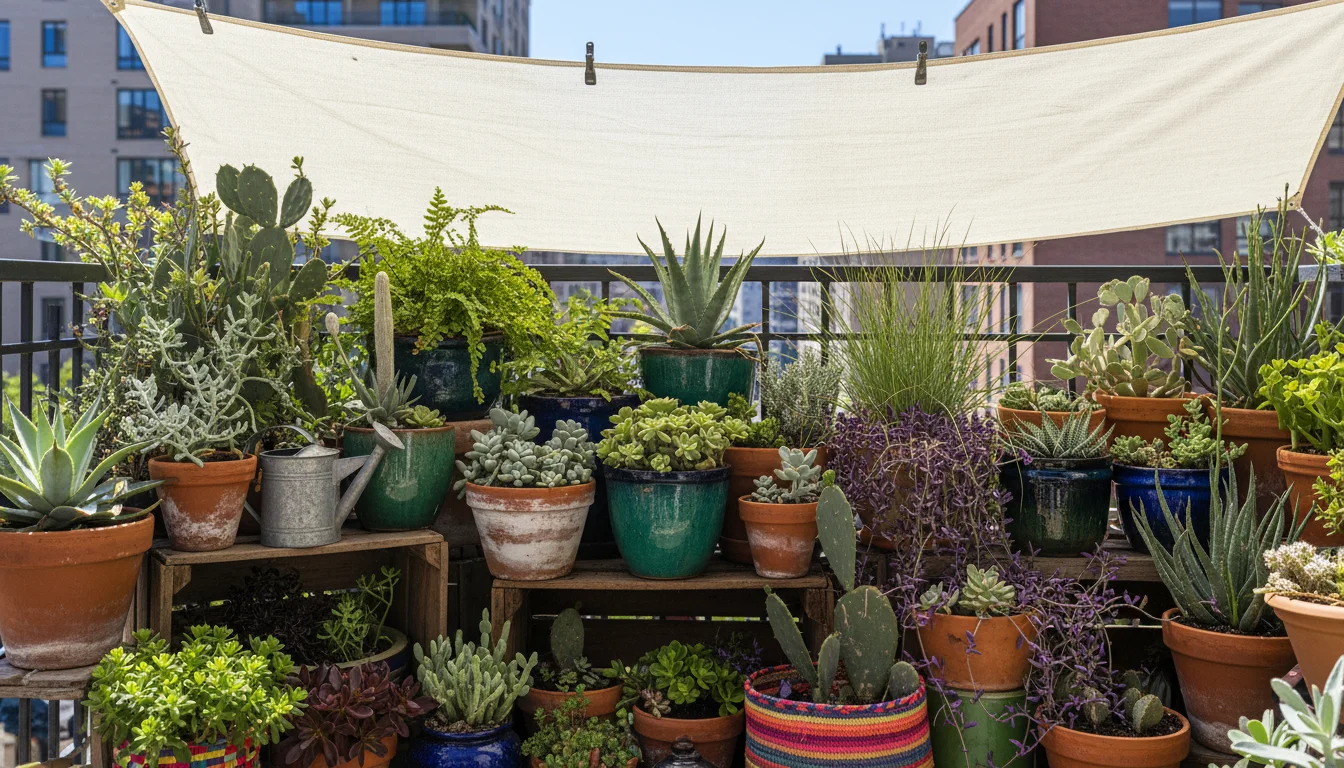
Small-Space Climate Resilience
Climate change brings more extreme weather, including prolonged heatwaves, stronger winds, and even late frosts. Your small garden needs strategies to withstand these challenges. Building resilience means protecting your plants from stress, ensuring they continue to thrive even in difficult conditions.
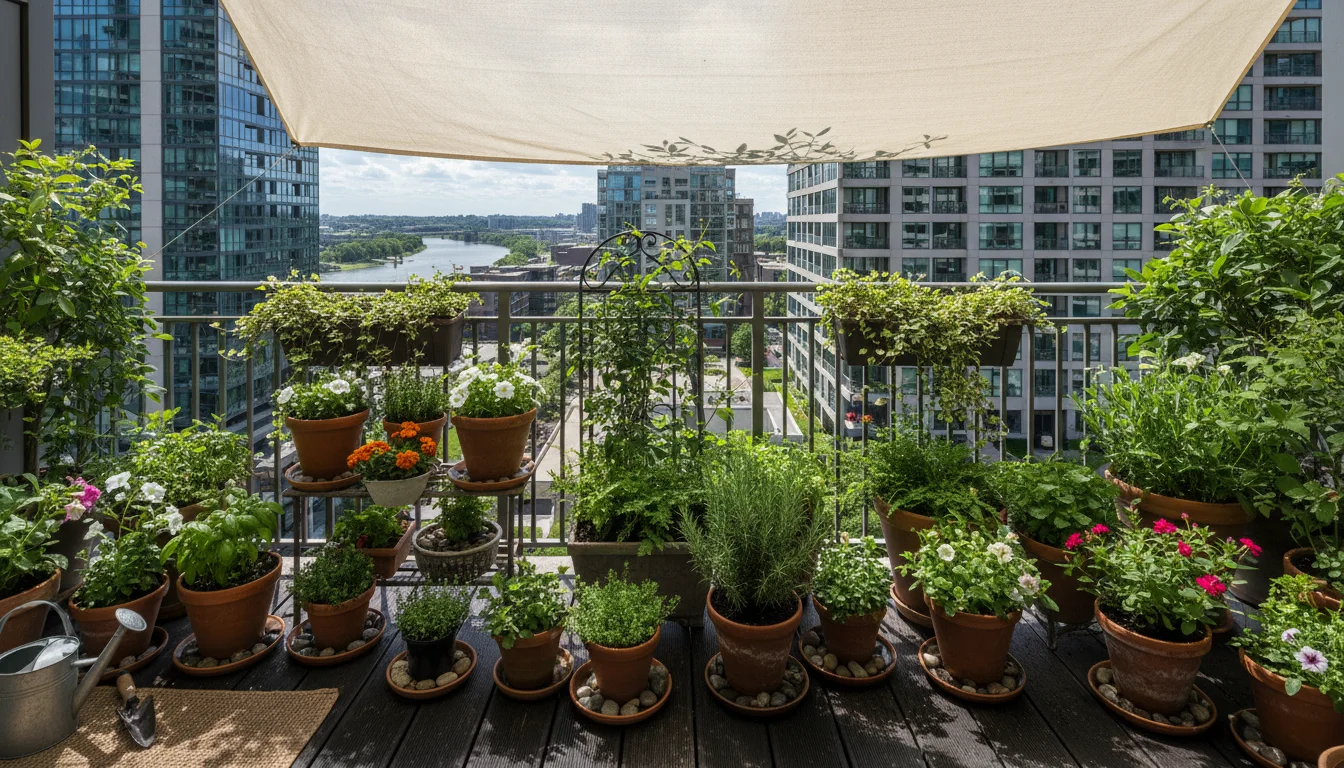
Protecting Against Heat and Sun
Intense sun and heat quickly desiccate containers and stress plants. Implement these strategies:
- Provide Shade:
- Shade Cloth: Install temporary shade cloth over your balcony or patio during the hottest parts of the day. This can reduce ambient temperatures by 10-15 degrees Fahrenheit and block a percentage of UV rays.
- Strategic Placement: Move containers to shadier spots during peak heat. Utilize larger plants to provide natural shade for smaller, more sensitive ones.
- Trellises with Vining Plants: Grow fast-growing vines on a trellis to create a living shade screen.
- Increase Humidity: Grouping containers creates a humid microclimate. You can also place saucers filled with pebbles and water around plants, ensuring the pot bases are not submerged. As the water evaporates, it adds humidity to the surrounding air.
- Cooling Pots: Wrap dark pots with burlap or reflective material to prevent excessive heat absorption. You can also double-pot by placing a smaller pot inside a larger one and filling the gap with insulating material like straw.
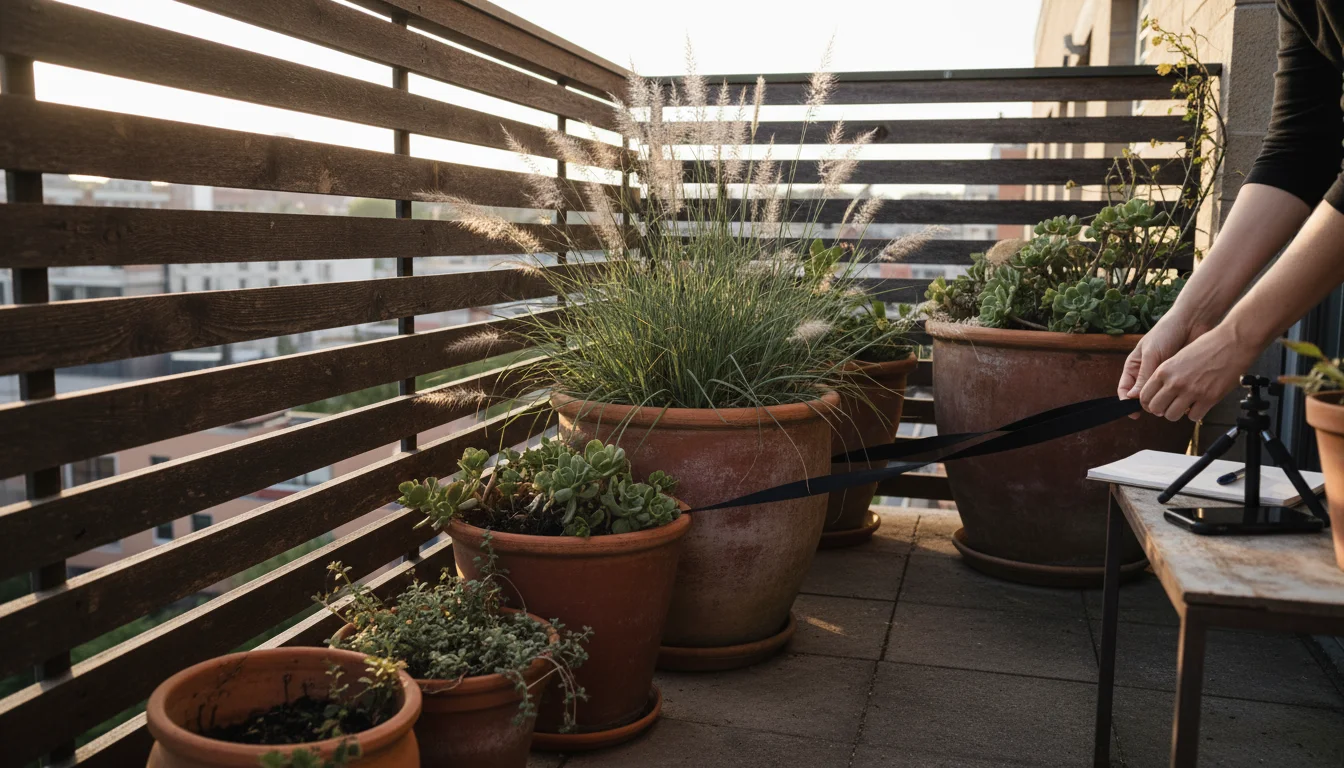
Managing Wind Exposure
Wind exacerbates water loss from plants and soil, and it can physically damage tender foliage. Small spaces, especially balconies, are often very exposed.
- Windbreaks:
- Solid Barriers: While effective, solid walls can create turbulent eddies.
- Permeable Barriers: Trellises with vining plants, slatted screens, or dense hedges (if space allows) are better. They slow the wind down without creating destructive turbulence.
- Secure Containers: Heavy winds can knock over pots. Use heavier containers, fill them with rocks at the bottom, or physically secure them with ropes or ties to railings or sturdy structures.
- Plant Choice: Select plants with flexible stems and small leaves that are naturally more wind-resistant.
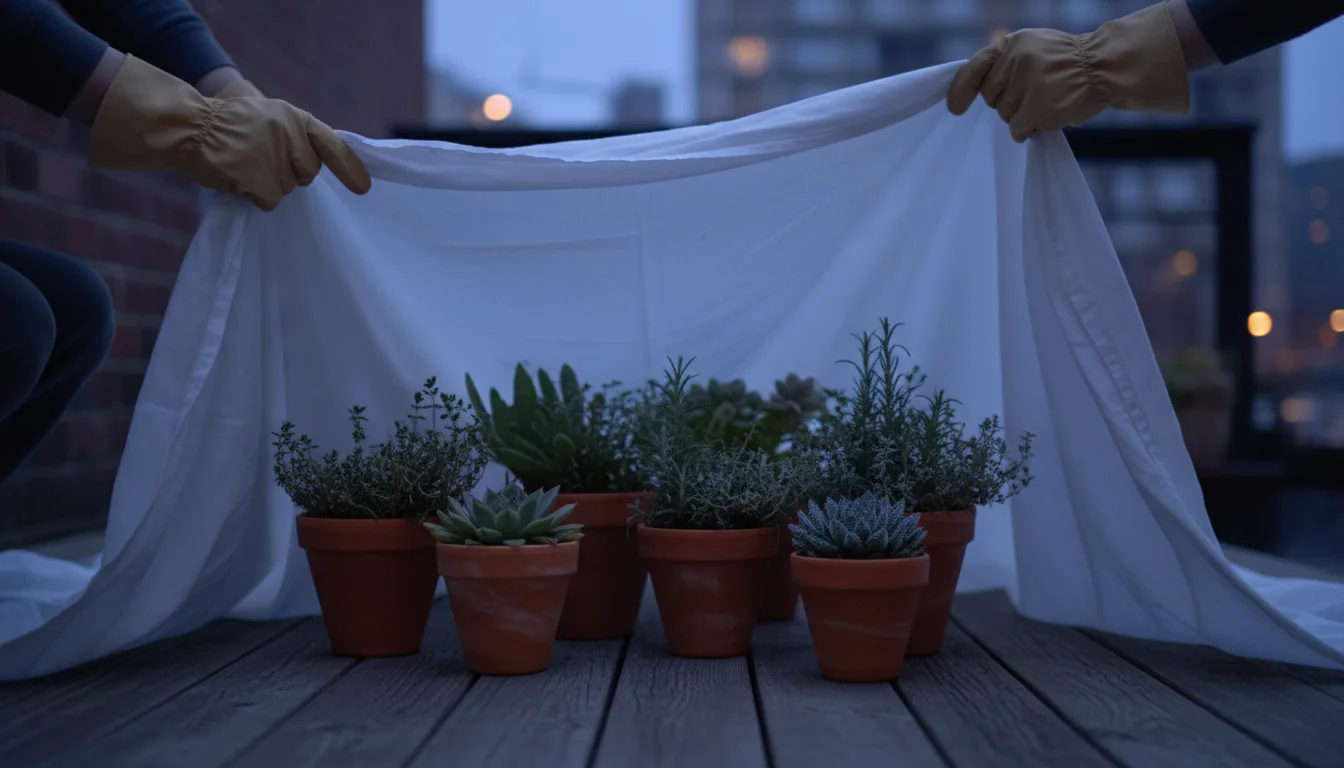
Preparing for Unexpected Frosts
Even in generally warm climates, late spring or early autumn frosts can surprise you.
- Monitor Forecasts: Pay attention to local weather predictions, especially during shoulder seasons.
- Cover Plants: Use lightweight blankets, bedsheets, or specialized frost cloths to cover sensitive plants before nightfall. Remove covers in the morning as temperatures rise to prevent overheating.
- Water Before Frost: A well-watered plant withstands cold better than a dry one. Moist soil radiates heat more effectively.
- Bring Indoors: For very cold-sensitive container plants, bringing them indoors overnight is the simplest and most effective solution.
- Clustering: Grouping plants together provides some mutual protection from cold.
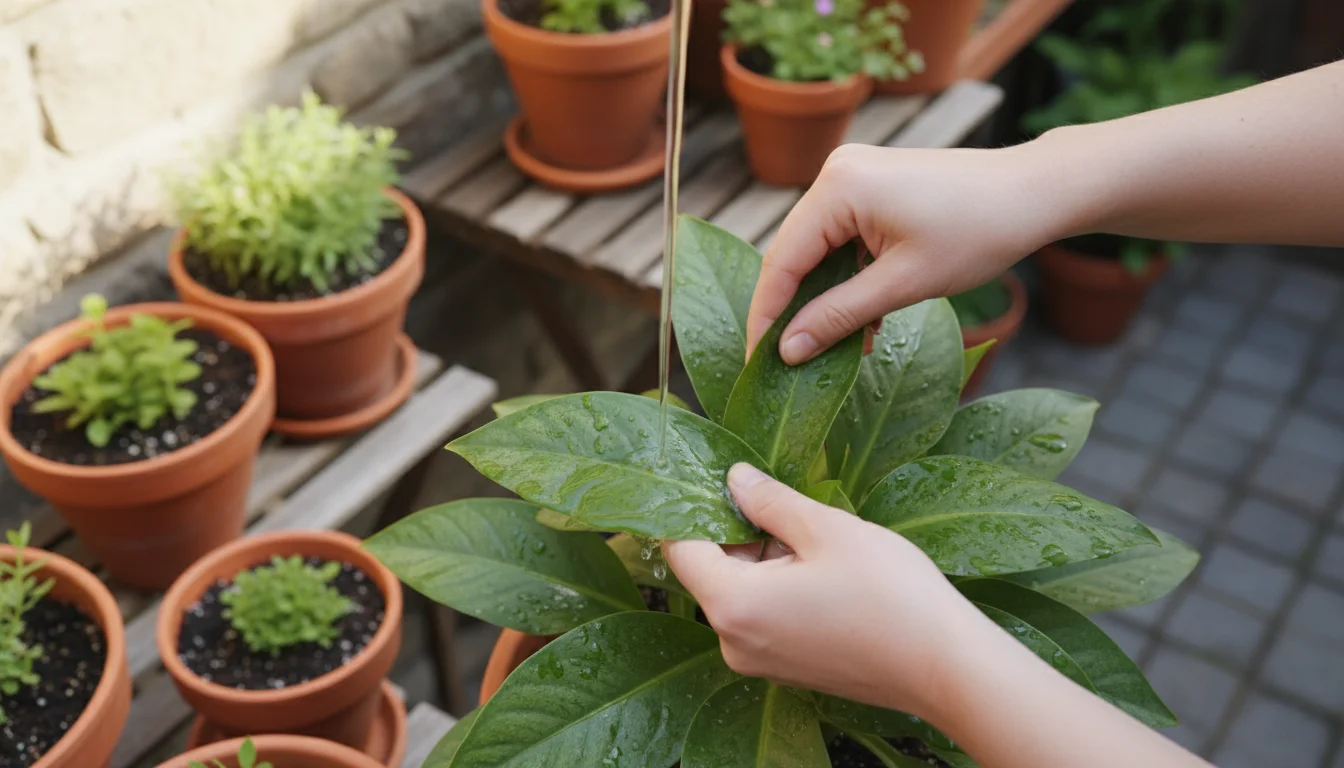
Smoke and Air Quality
Wildfires and urban pollution can impact your garden’s health. While specific measures are limited for small outdoor spaces, consider:
- Rinsing Foliage: After a smoky period, gently rinse your plants with water to remove ash and particulate matter, which can hinder photosynthesis.
- Plant Respiration: Ensure your plants are well-watered and healthy, allowing them to better cope with air pollution stress.
By implementing these resilience strategies, you create a garden that is not only water-wise but also robust enough to face a changing climate.
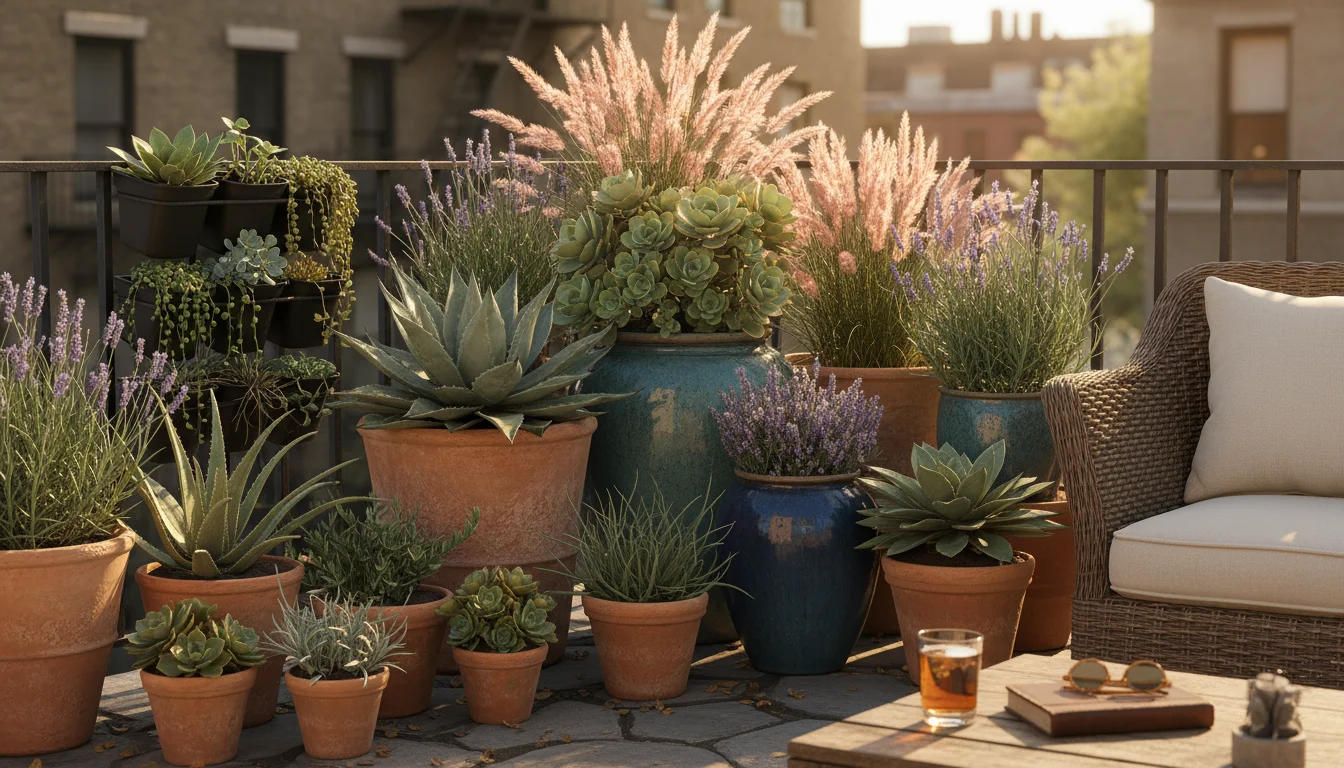
Frequently Asked Questions
What is xeriscape gardening?
Xeriscape gardening is a landscaping method focused on water conservation through efficient irrigation, appropriate plant selection, and smart design. It involves choosing drought-tolerant plants, improving soil with organic matter, using mulch, and watering efficiently to minimize or eliminate the need for supplemental irrigation.
Can I really grow vegetables with low water?
Yes, you absolutely can grow vegetables with low water, especially if you select drought-tolerant varieties. Some excellent low-water vegetables include tomatoes (once established), peppers, eggplant, melons, gourds, pole beans, and many herbs. Focus on deep, infrequent watering, enrich your soil with compost, and use mulch. Self-watering containers are particularly effective for thirsty edibles.
My plants look wilted in the afternoon, but perk up by morning. Are they dehydrated?
Often, a slight afternoon wilt, especially on a hot day, is a plant’s natural response to conserve moisture. It reduces the leaf surface area exposed to the sun. If your plants recover by morning, they are likely not severely dehydrated. Check the soil moisture. If the soil is dry 2-3 inches down and they remain wilted in the morning, then it’s time to water.
Is peat moss good for water retention in containers?
Peat moss does hold a lot of water, but it’s a non-renewable resource harvested from peat bogs, which are critical carbon sinks and ecosystems. For sustainable low water gardening, use alternatives like coconut coir, compost, or well-aged pine bark fines. These options also offer excellent water retention and improve soil structure without the environmental impact.
How can I tell if a plant is truly drought-tolerant before buying it?
Look for specific plant characteristics: silvery or fuzzy leaves, thick or succulent foliage, narrow or needle-like leaves, and deep green or grayish-green coloration. Check plant tags for water requirements, often described as “low,” “moderate,” or “xeriscape.” Research the plant’s native habitat; if it’s from an arid or Mediterranean climate, it’s likely drought-tolerant. Ask your local nursery staff for recommendations specific to your area’s drought conditions.
For research-based sustainable gardening guidance, see
USDA NRCS — Soil Health,
Royal Horticultural Society (RHS) — Gardening Sustainably,
University of Minnesota Extension — Composting, and
The Xerces Society — Gardening.
Disclaimer: This article is for informational purposes only and is not a substitute for professional advice. Check local regulations before installing rain capture, using greywater, or composting food scraps outdoors.
